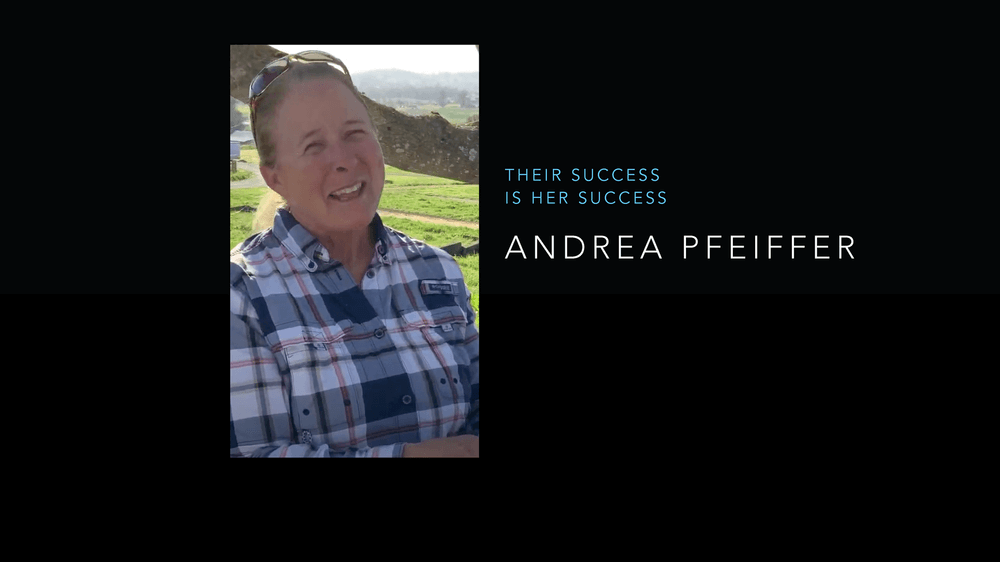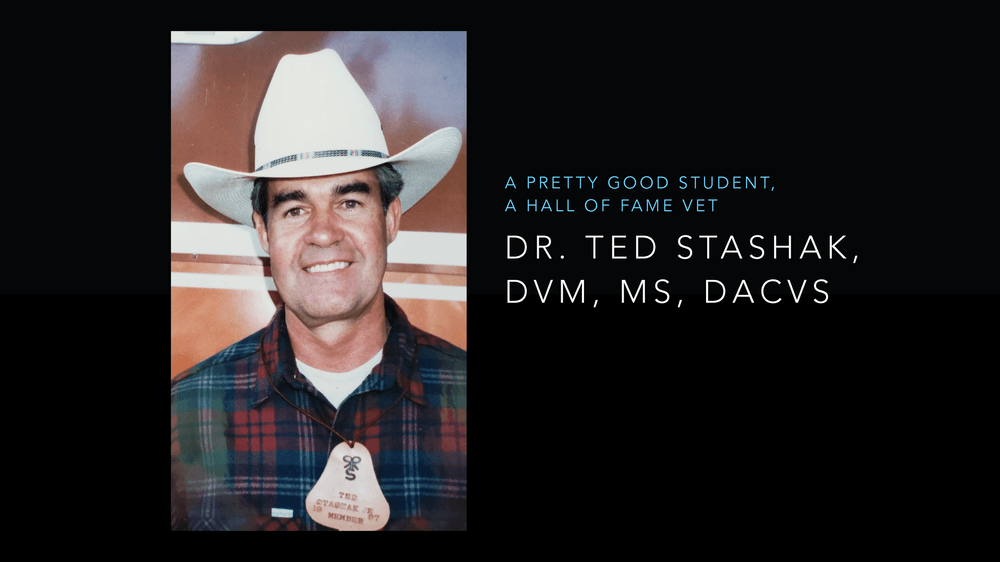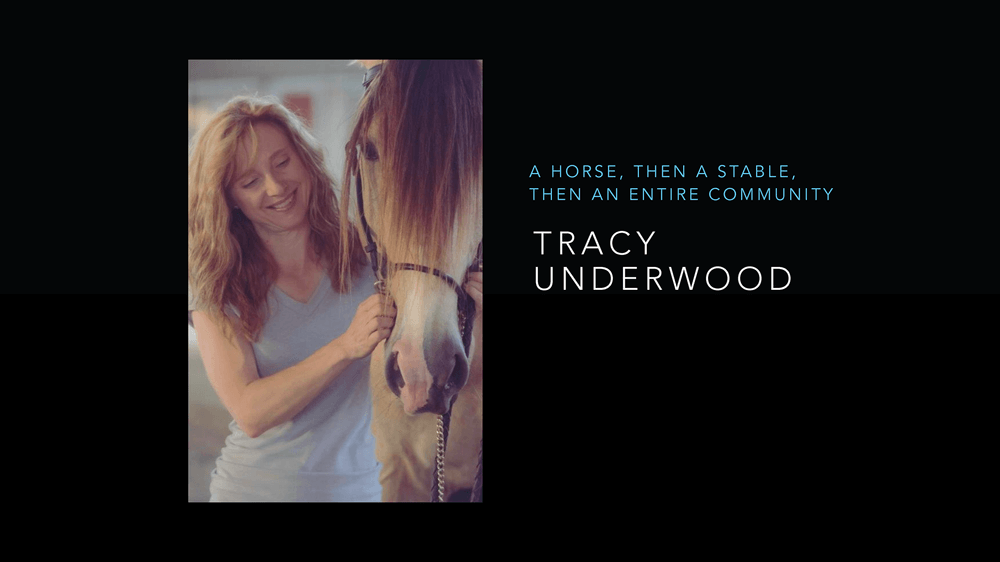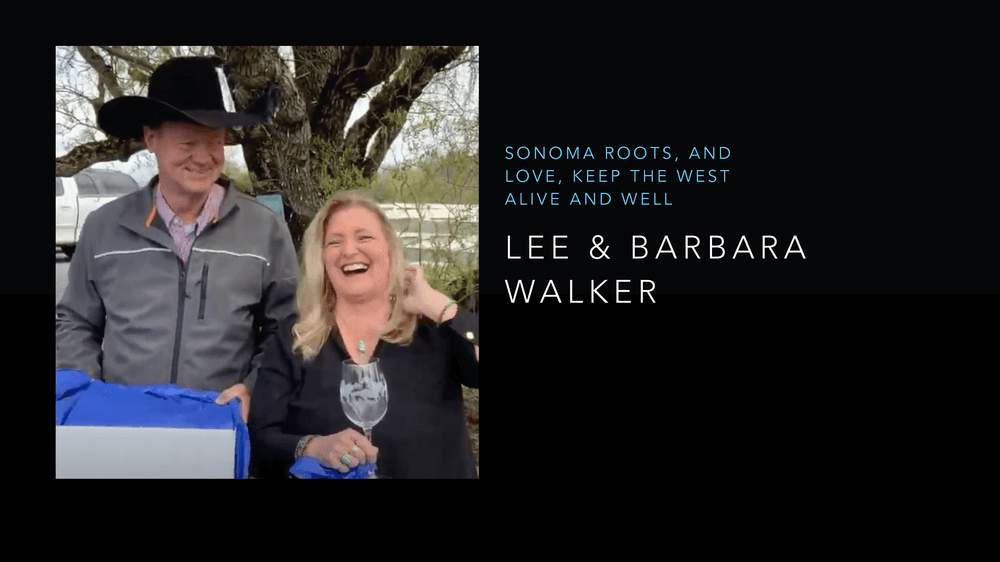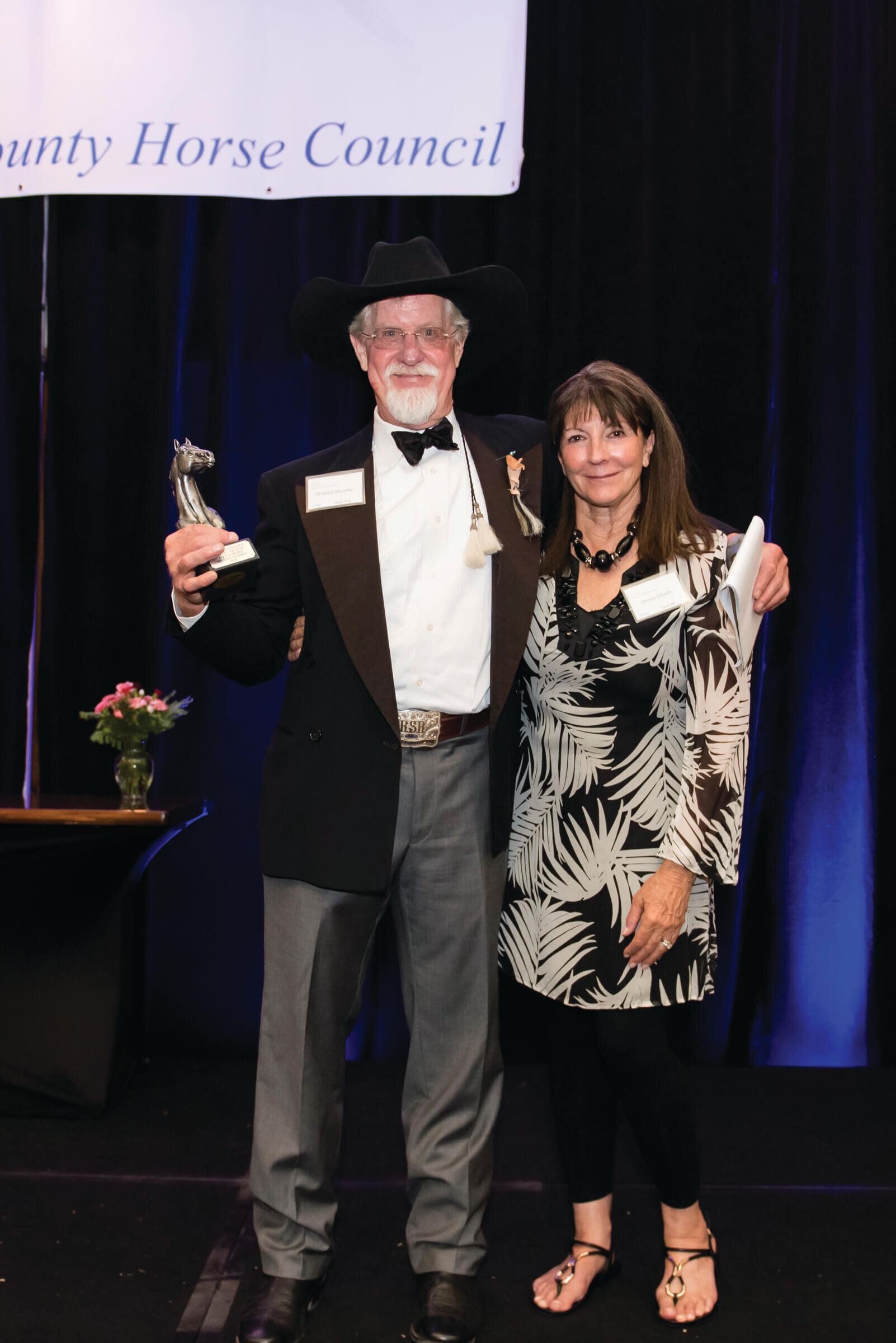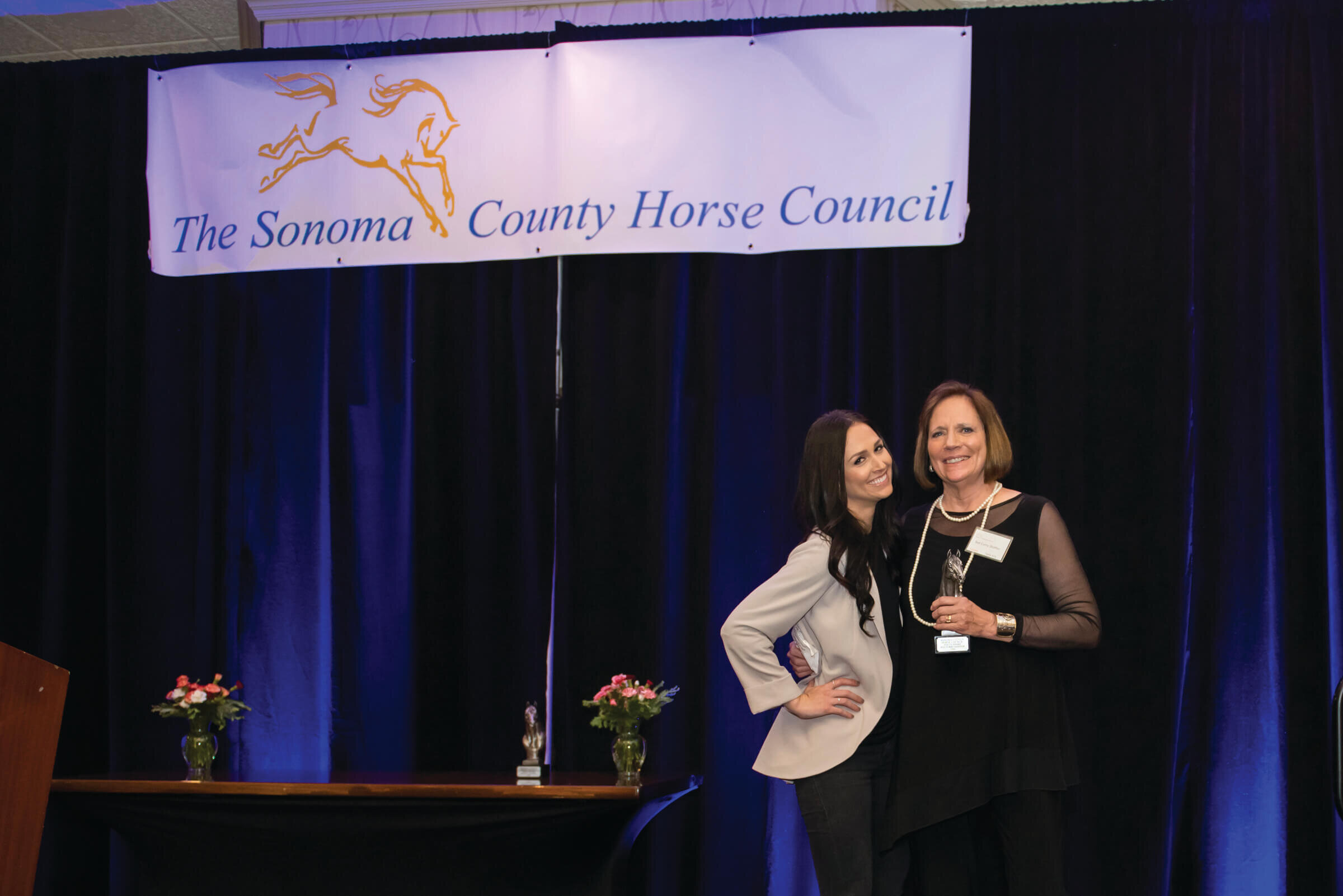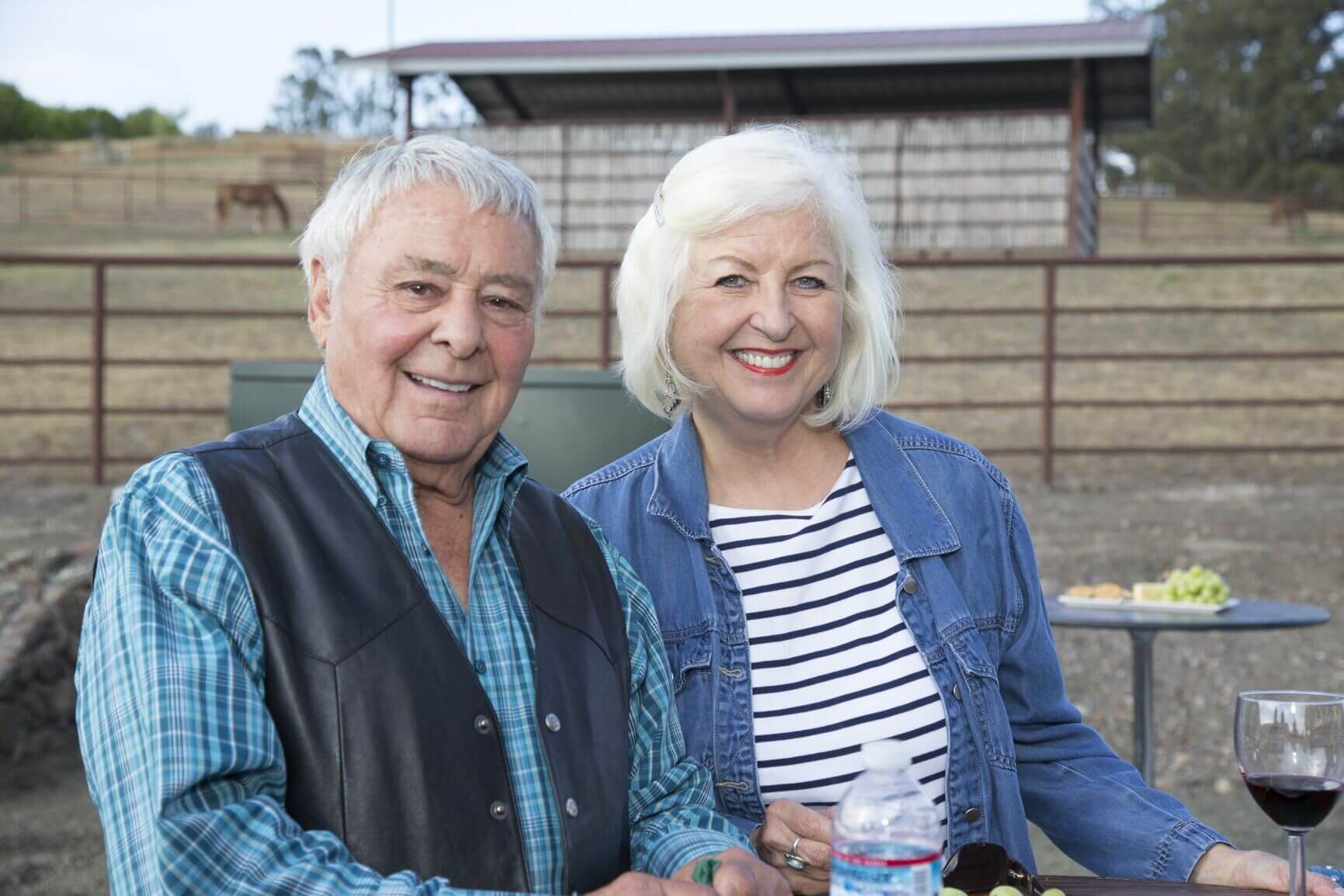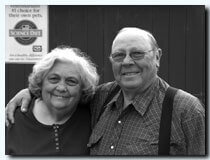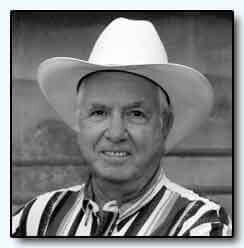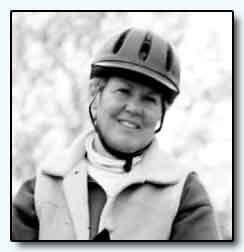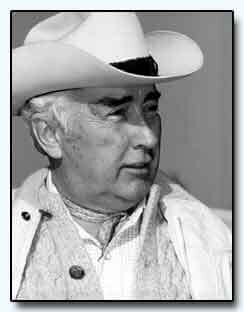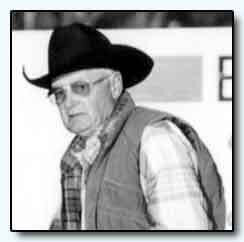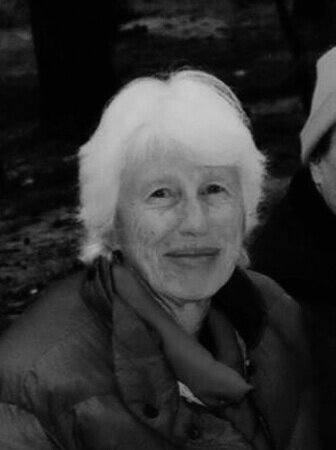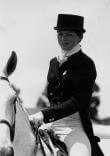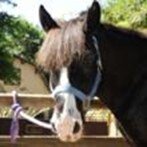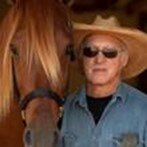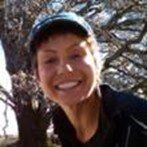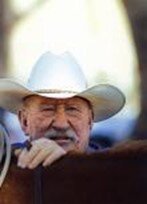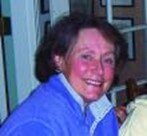Equus Hall Of Fame
13th Equus Award Winners
Andrea Pfeiffer
Andrea has spent decades in Sonoma County, coaching 3-day eventers (horses and riders) from the beginning levels to international success. Her commitment to students, horses and the community is widely acknowledged. She truly leads by example.
Watch acceptance video
Ted Stashak, DVM, MS, DACVS
Ted Stashak, DVM, MS, DACVS - Sonoma County native, Dr. Stashak has practiced veterinarian medicine for over 50 years and is nationally recognized for his contributions to equine surgery and veterinary education. He spent countless hours laying the foundation for Sonoma County’s large animal disaster plan, and was integral in the sheltering of large animals during the 2017 wildfires.
Tracy Underwood
During the sixteen years Tracy operated the Santa Rosa Equine Center, she hosted the European Pony School, countless events, and clinics, and sheltered horses and families during the 2017 and 2019 wildfires. Her shows and continuous volunteer work in Sonoma County are a special legacy.
Lee and Barbara Walker
Lee and Barbara Walker — Multi-generational Sonoma Countians, Lee and Barbara have worked tirelessly for years to put on organized, safe and fun rodeo and barrel racing events, including the Russian River Rodeo, Sonoma County Trailblazers Annual Rodeo and events for the Sebastopol Wranglers.
Watch acceptance video
Royal Crest’s Rockappella (Barbie)
The 27-year-old American Saddlebred mare known affectionately as Barbie, laid down in the warm sunshine for the last time in 2020. From her impressive show career to her 15 years as a rock-steady lesson horse for riders of all ages, her patience and gentle manner -- whether in the arena or decorated as a sheep or unicorn -- provided children and adults with a joyous introduction to riding.
13th Equus Awards Photo Gallery
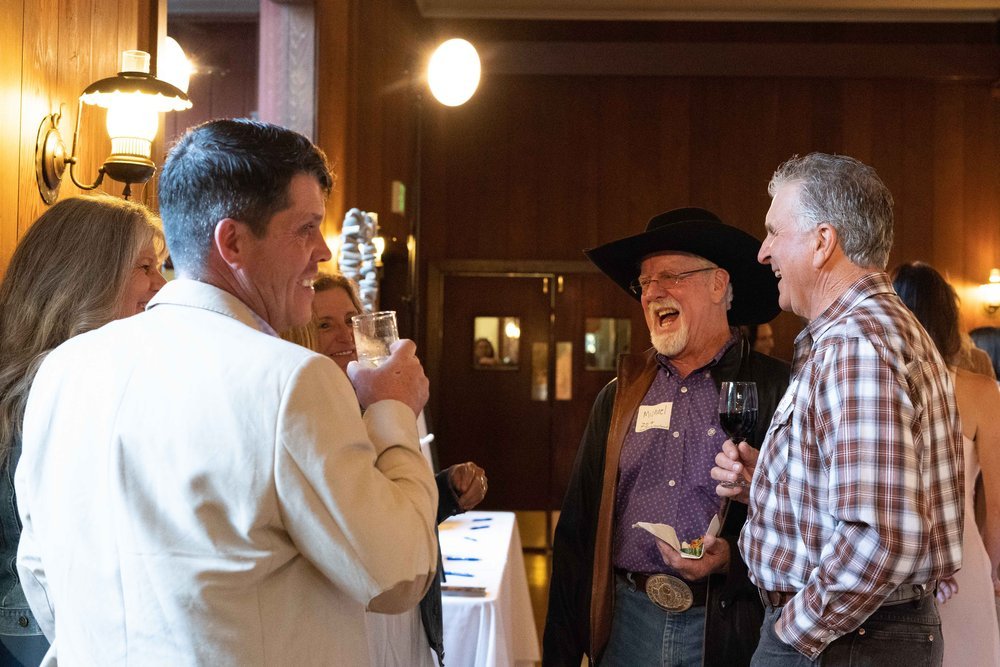
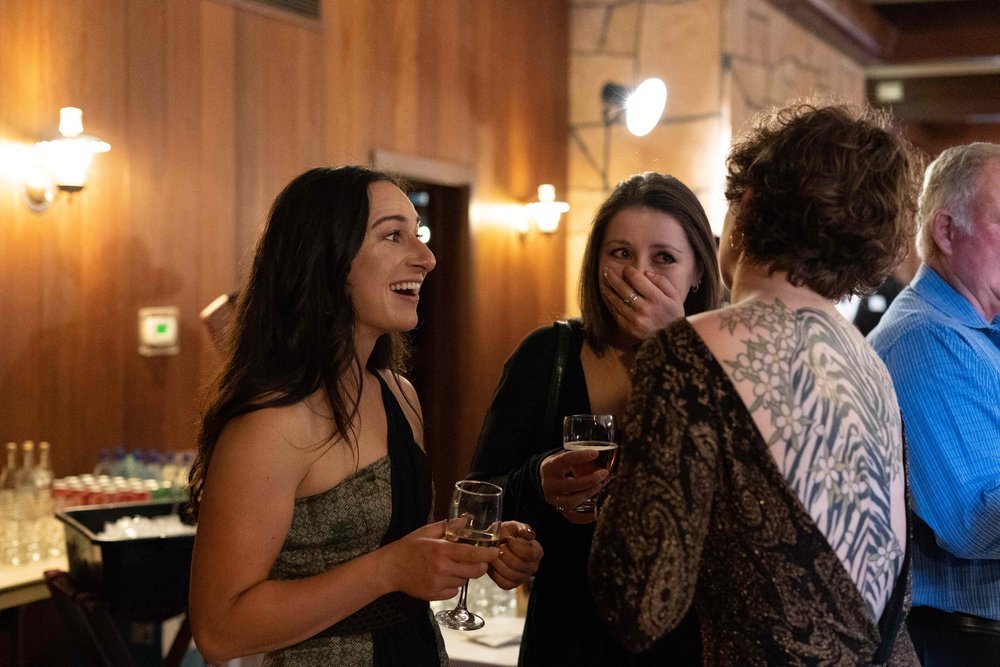
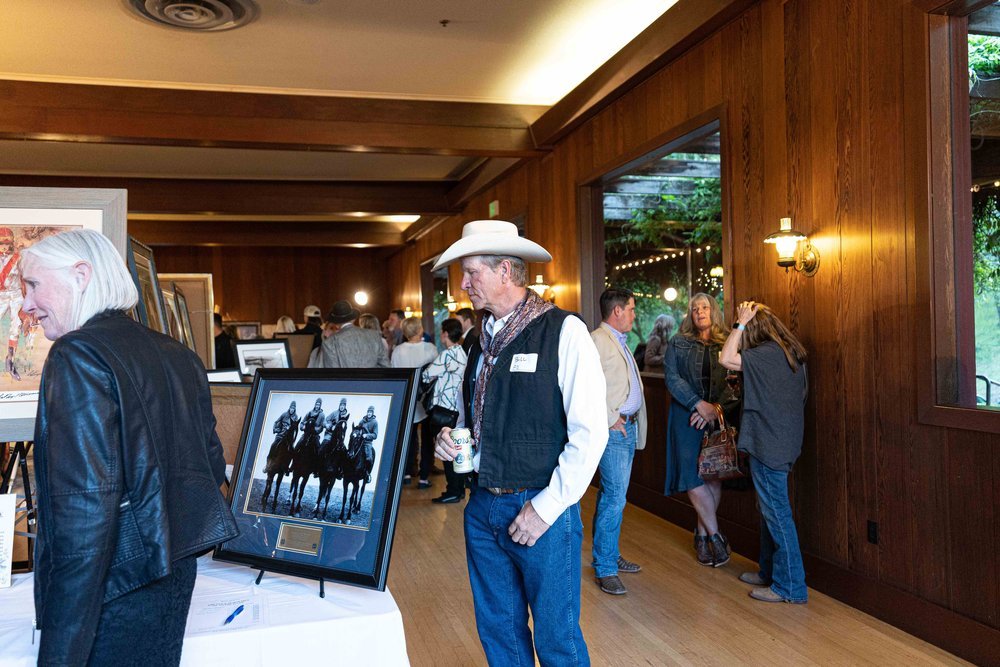
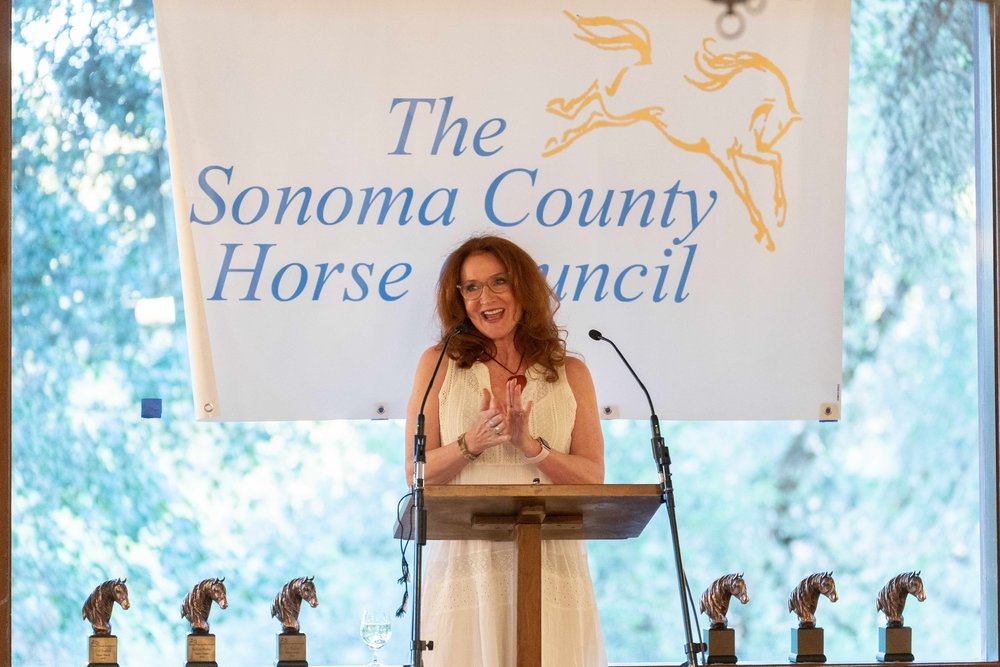
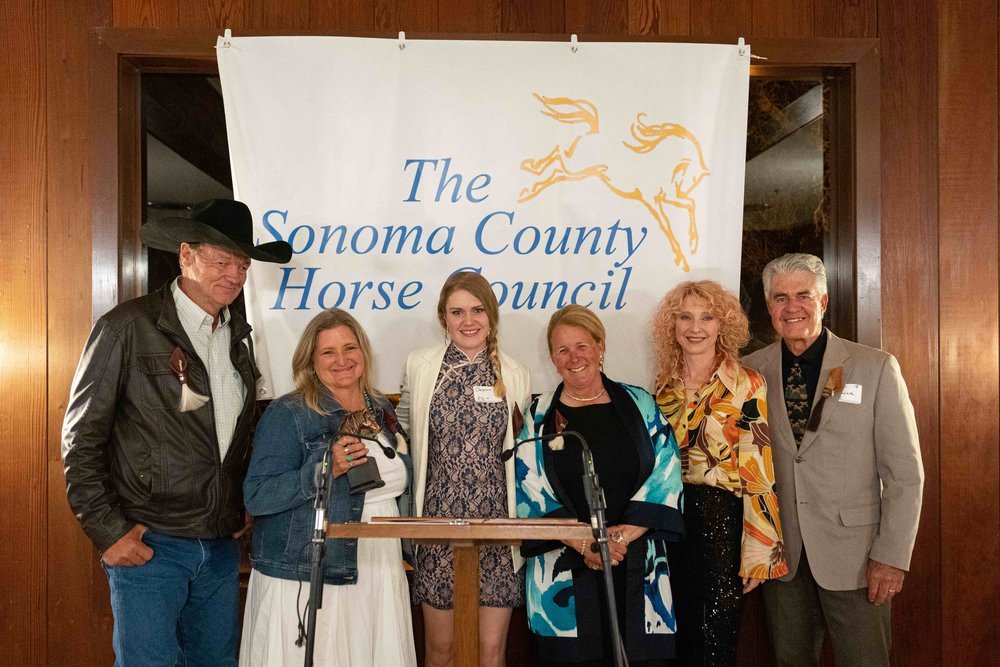
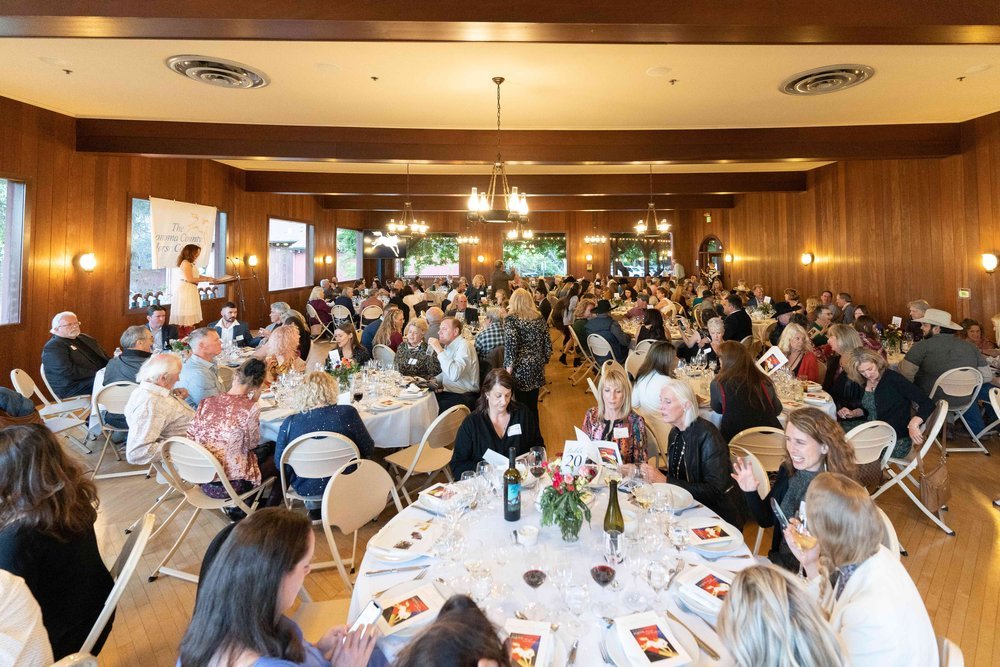

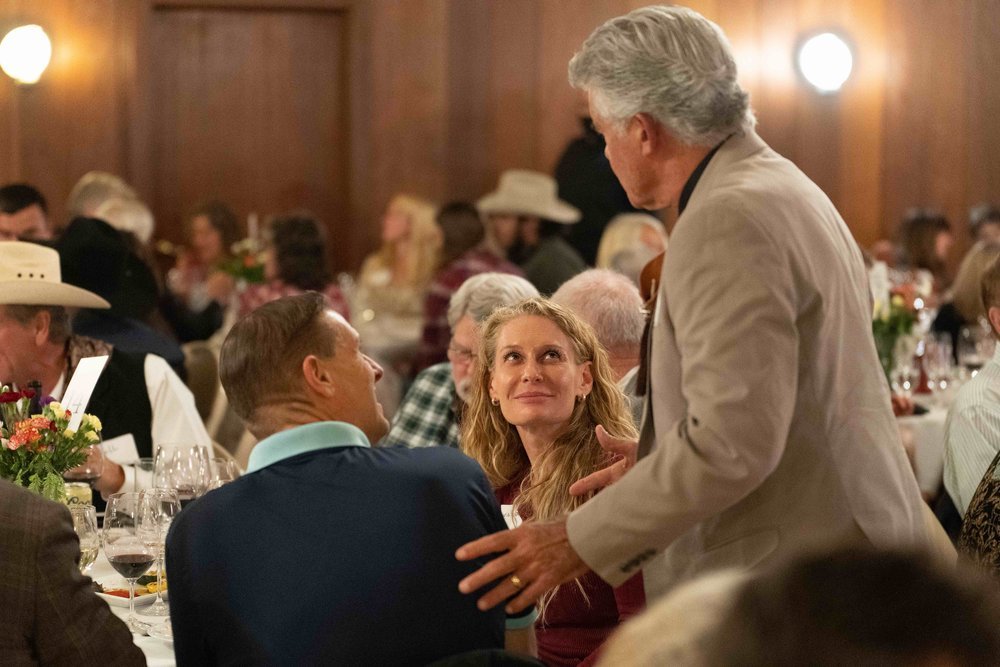
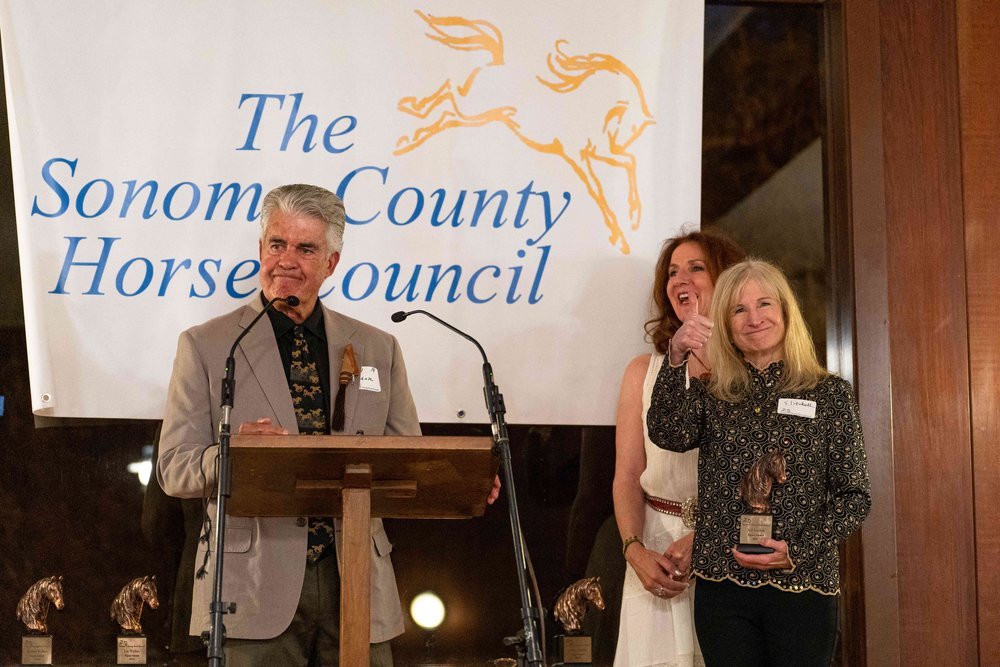

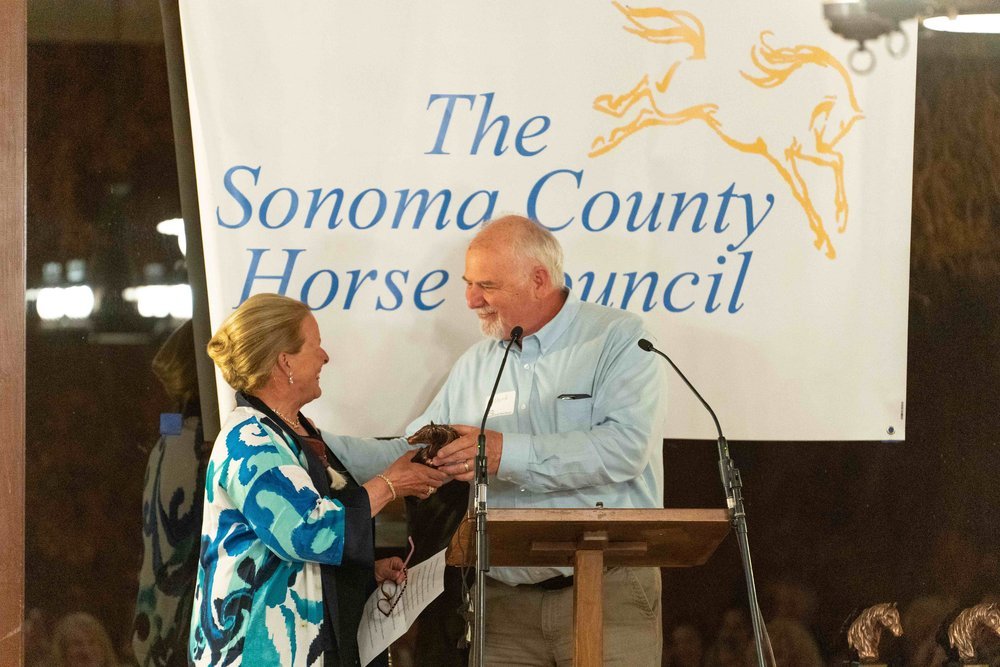
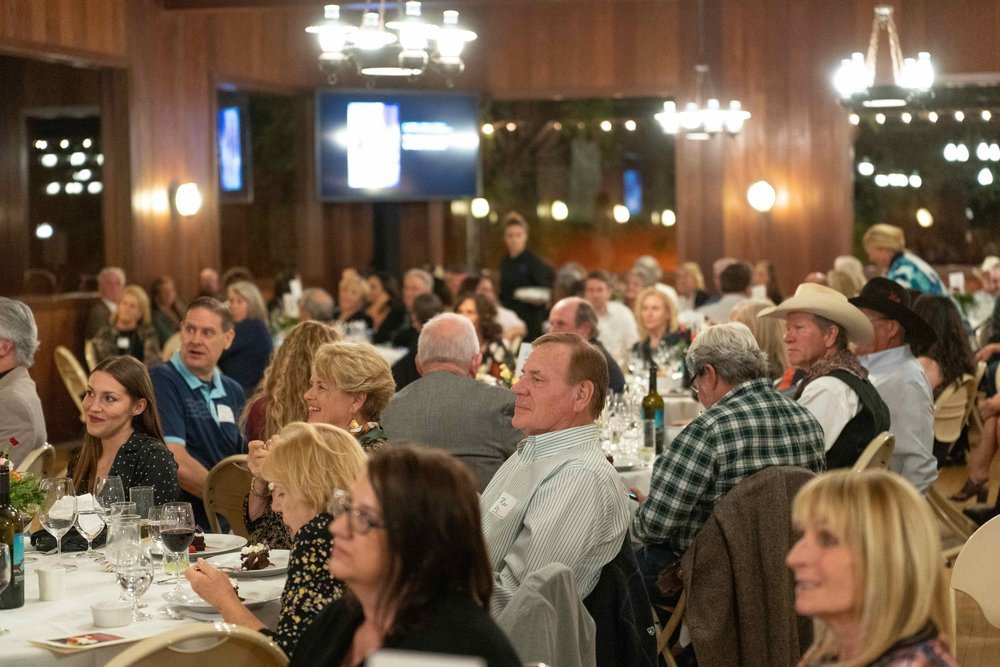
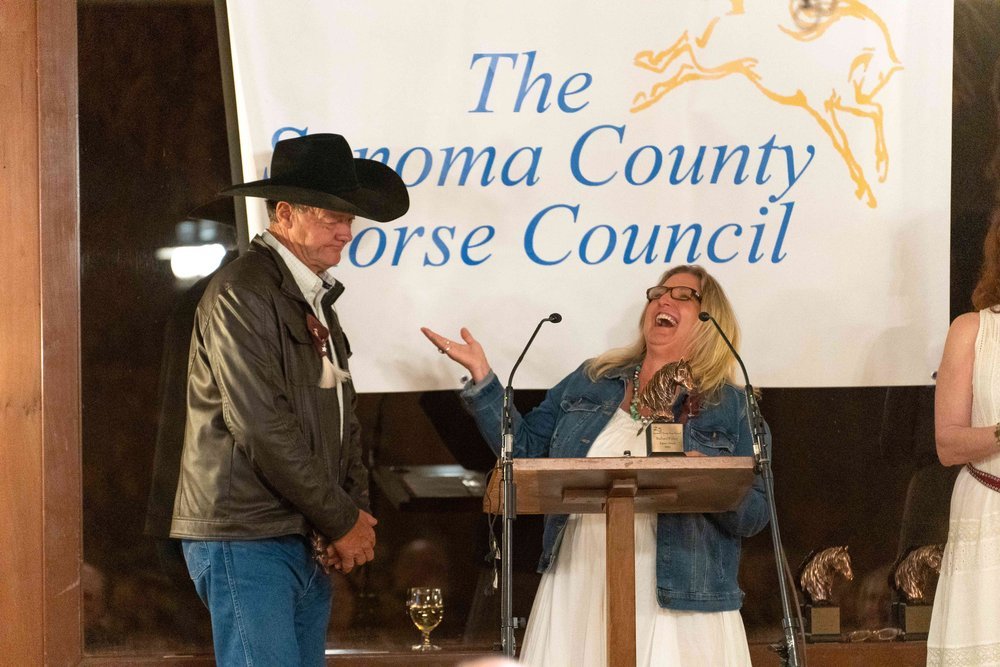
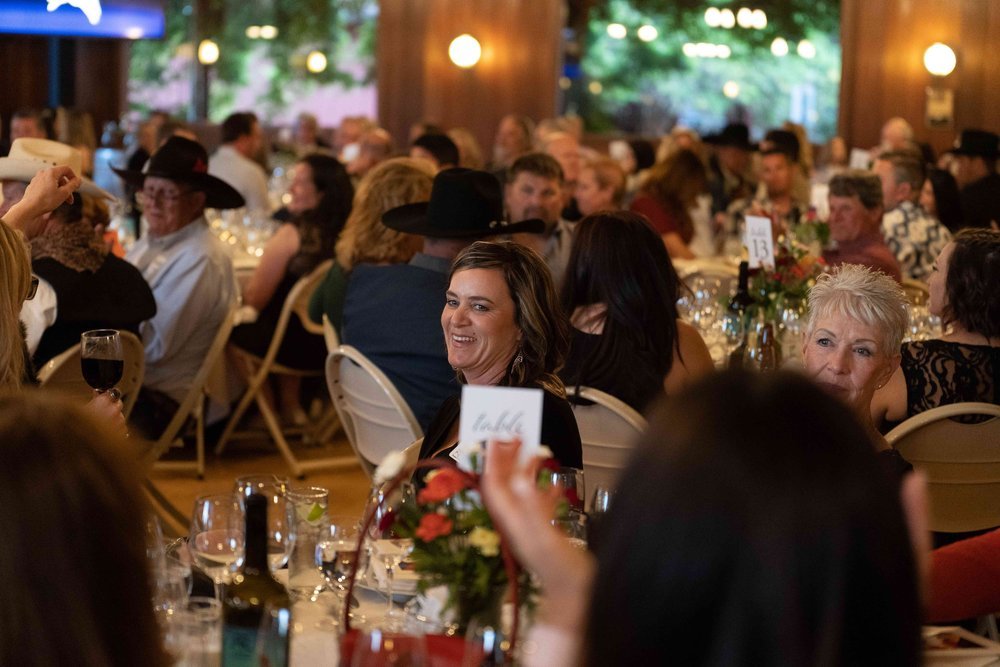

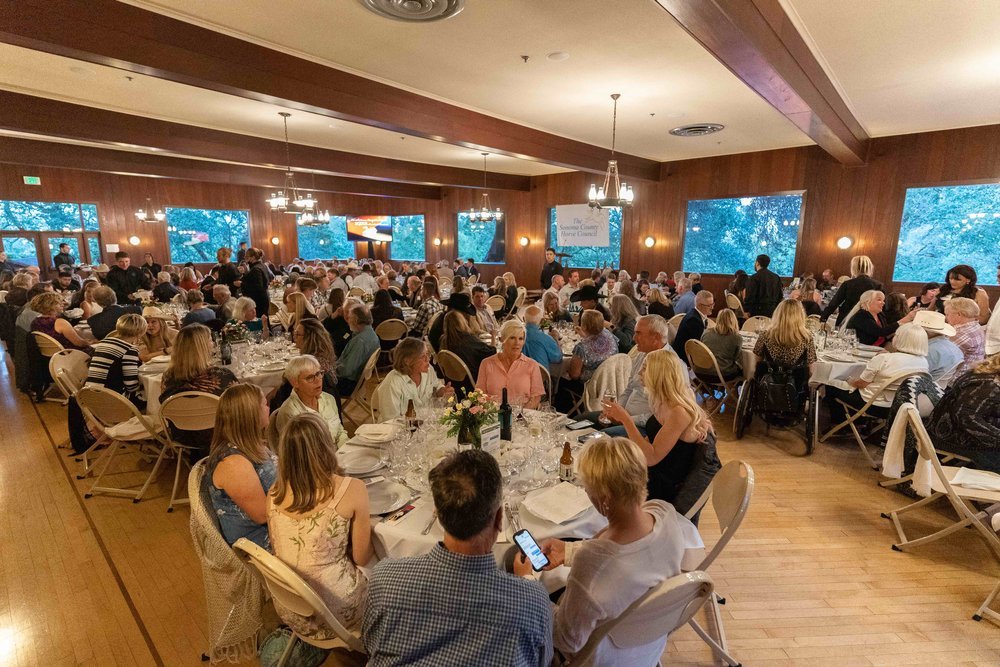
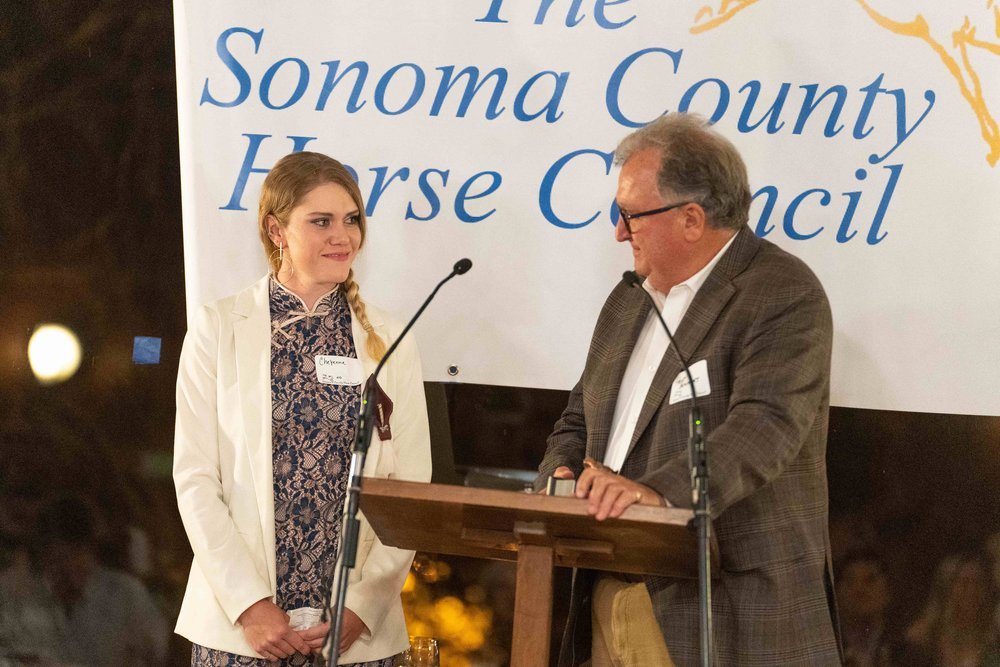
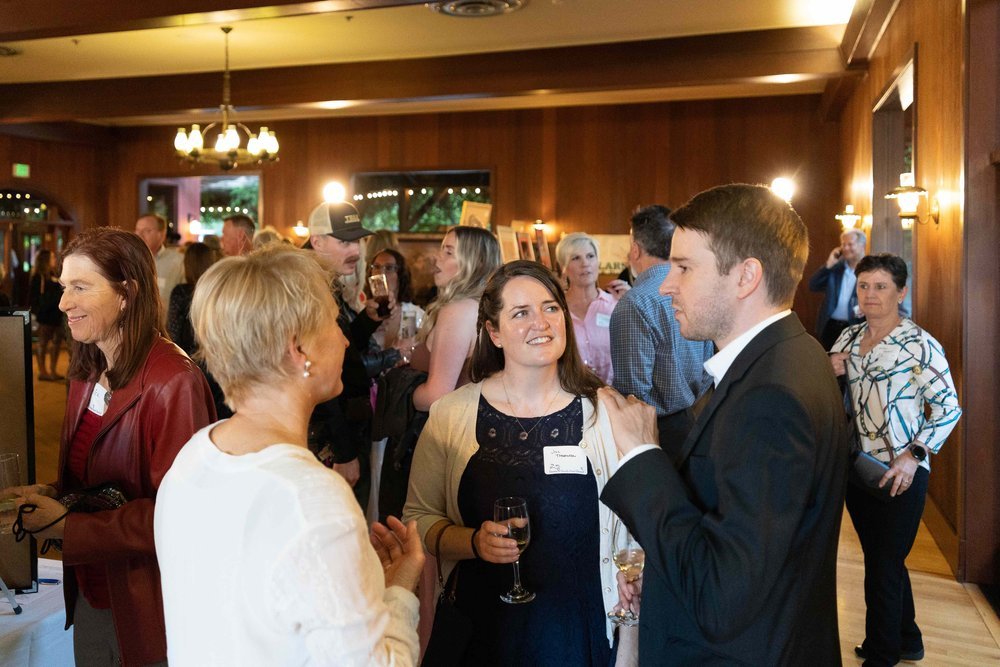
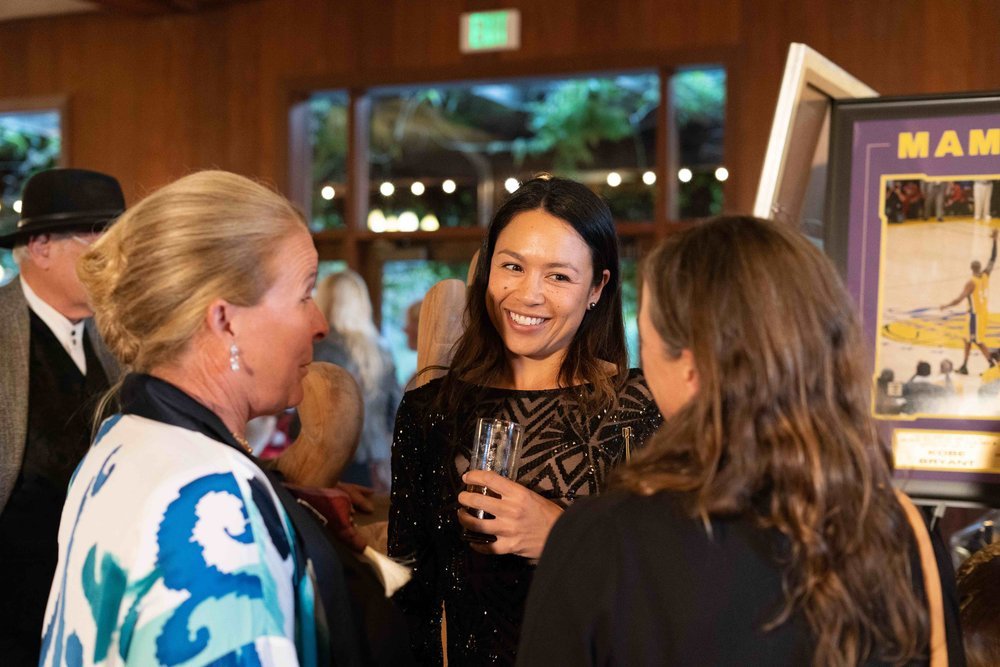

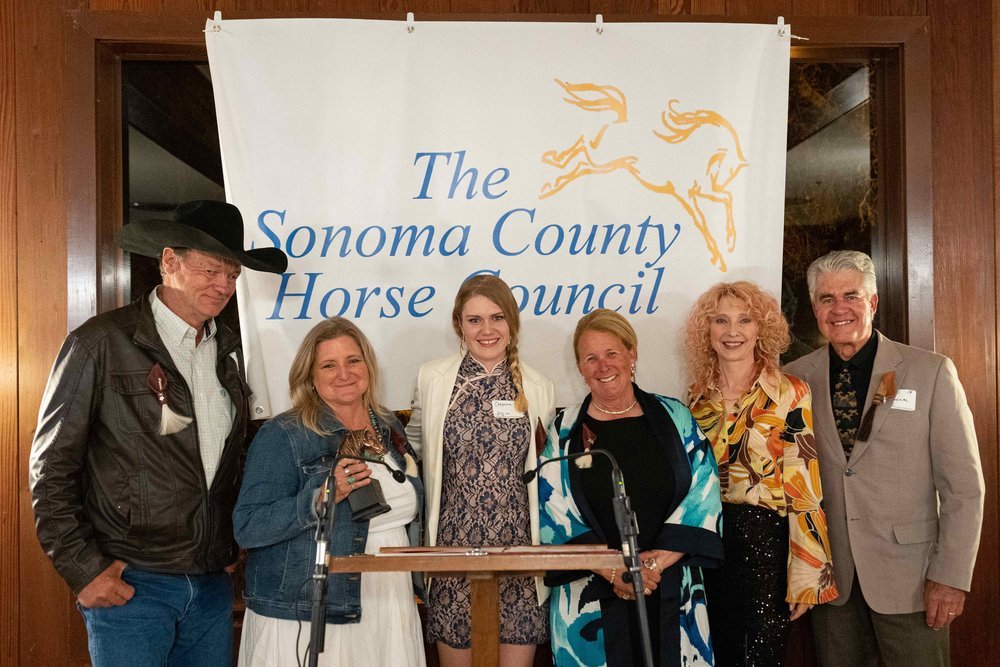
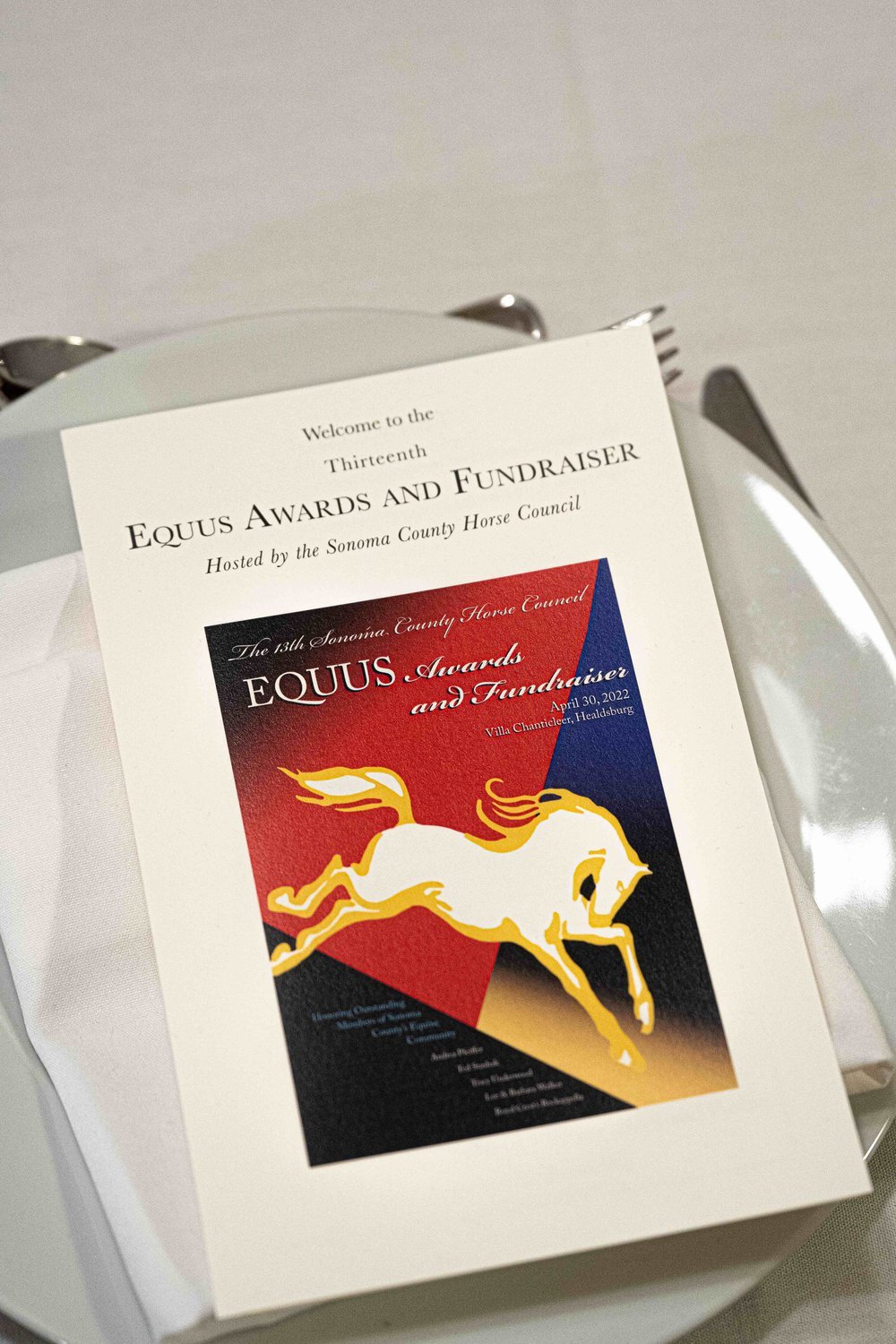
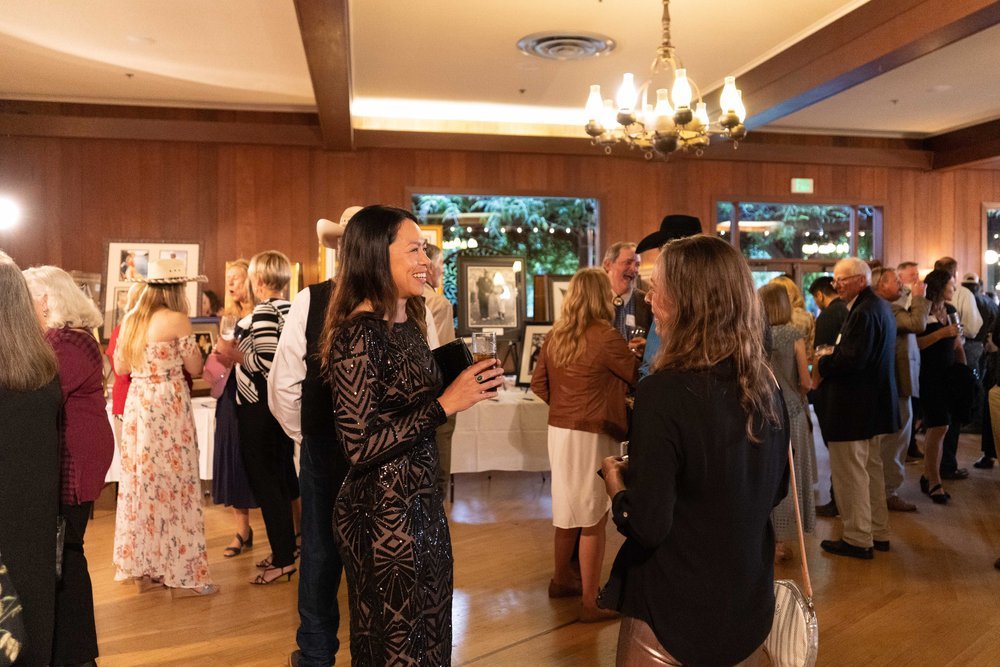
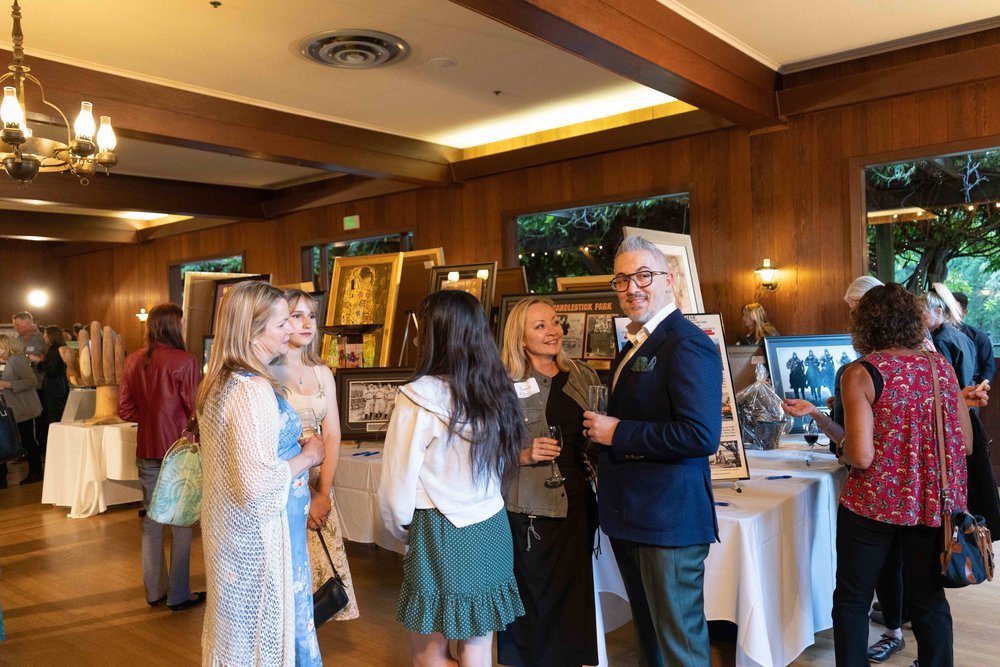
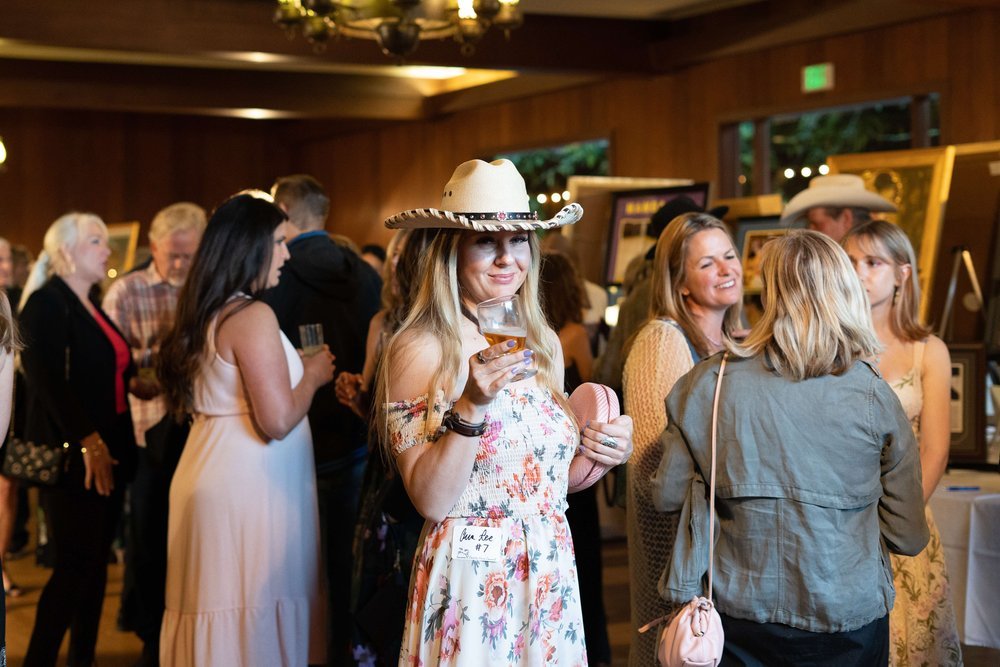
Photos courtesy of Dominic Bower
12th Equus Award Winners
Jonathan and Laura Ayers
Jonathan’s family moved inland after he was born in Southern California, and he didn’t really find himself until he lived in Wyoming. Laura was raised where she and Jonathan live now, deep in Armstrong Woods, on land her father bought for its timber. As a girl, she rode her horse on wildlife trails amidst majestic trees, where she also learned to drive a logging truck by the time she was eleven.
They both traveled extensively as young adults, and it was on an international trip that Laura and Jonathan first met before continuing on separate paths, but they’d meet again.
Laura came back to Sonoma County 45 years ago to homestead her family’s land. Jonathan made his way back via a Wyoming pack operation, a Texas cattle ranch, and a breeding operation in California, which is where he was when he tracked down Laura and reestablished their connection. They’ve been together since.
In the early eighties, their shared love of nature and horses came together—or, as Jonathan describes, “we had one horse, then another, then, suddenly we had a lot of horses!” A vendor approached the park service about doing horseback rides in the park, then came to them and said, “if we’re going to let someone do that, though, we prefer that be you.”
30-years later, Armstrong Woods Pack Station had guided 25,000 people across 25,000 miles of trails through Sonoma County’s greatest nature area. They also found time to teach six-hundred Camp Newman kids how to ride and learn from horses. They did the same thing for a different group, creating and operating a program for adults with serious limitations resulting from traumatic illness, accidents, and other life-altering ailments. Jonathan recalls, “I’ve learned a lot, and my horse, Dox Why Worry, he was the boss, taught me more than I could have ever learned on my own. We had the opportunity to open that experience to others who might not ever have known what horses can do for us. Working with those challenged adults changed them, and it changed me too.”
They recently ended the pack operation, closing a decades-long chapter in their lives. Their legacy now resides in the memories of those lucky enough to have experienced once in a lifetime trail rides, and with those who, for a brief moment, left their limitations in the dust of special horses, led by very special guides.
Amber Bowen, D.V.M.
Her 1967 Ford Mustang is her only horse right now, but Amber has never had a shortage of animals, going back to Missy—“Pissy Missy,” as Amber fondly calls her—a paint pony she found walking along Ross Road and took home to Forestville. “Dad said if you have a horse you need a trailer, so I found an ad for one and talked the guy down to one-hundred-and-twenty-dollars.” Amber was all of twelve.Solutions came easy to Amber, like acing college-level math in grammar school. She went from El Molino to Cal Poly for a BS in physics and a Masters in agriculture, then graduated from UC Davis vet school.
Amidst all that learning, she co-founded International Veterinary Outreach in 2011, a nonprofit providing free veterinary care and education to developing countries. She’s taken vet teams to the Philippines several times, and Nicaragua.But she always wanted to get back home. After work in Australia, Southern California and Florida, she came back, worked two years with a Sonoma County practice, and then went out on her own. There’s no transition here that can easily take us back to October 9th, so we’re going right to the fairgrounds: After a night evacuating her own, friends’, and clients’ animals, Amber arrived at the fairgrounds the next morning to treat a colic. She and Horse Council board member, Dr. Ted Stashak, organized sheltering even as they evaluated a stream of arriving horses and other animals. For two weeks she coordinated hundreds of volunteers, vaccinated, put biosecurity protocols in place, dealt with strangles, colic, corona virus, and treated injured animals. From her education and experience, she knew “mass animal emergencies are as much about humans as animals; human management is a necessity.” 50-percent of the people there are her clients, and other clients, friends, the Office of Emergency Services, everyone showed up and asked, ‘what do you need?’ Her husband, Martin, was out of the country, and her parents moved their trailer to the fairgrounds so Amber didn’t have to leave. The Equus Awards focuses on a nominee’s history and accomplishments, but Amber’s depth of experience and actions under fire deservedly flip that focus, as best described by her nominators: “her calm control of the situation, compassion, vet skills, and patient empathy minimized animals’ and owners’ anxiety during a historic evacuation…she is already an exceptional member of our equestrian community.”
Michael Murphy
On top of, or working behind a horse, Michael Murphy is the go-to guy for many people in this room. He’s got an expertise that has become incredibly important, even high profile, in this day of sustainability and the environment. And he’s all ours.
He’s a long way from his Mississippi upbringing, the brother to 6 younger sisters. Yikes. He was outta the south not too long after graduating with an environmental planning degree, reaching the freedomland of San Francisco in 1970. Working part-time day jobs and playing in bands at night, he moved north over the next few years until he reached Sebastopol, where he bought his first horse. Then, with all that horse experience to guide him, he quickly bought another. Yikes, again.
Gathering riding experience through rides and joining the Backcountry Horseman of California, he began to grow his niche business, um, we’ll call it waste management. An easy talker, he became known throughout Northern California, talking with horse owners, ranchers, cattleman and stable owners, and arrived in the perfect place to lead them as a future of one-sided, complex water and waste management regulations threatened to overwhelm the local horse and dairy industries.
You heard it earlier: conversations turned to meetings, meetings created consensus, and Michael laid those planks that became the Horse Council’s foundation. But he also infused that creation with the right qualities, ensuring that agendas or vendettas were put aside, positioning the Council as an organization to get things done, and work with government, not against it.
He might have come a little later to horses than many of us, but he caught up fairly quickly, joining with riding clubs, working with open space districts, and putting his own family roots deep into Sonoma County. The trails he took to get here don’t matter to us as much as that he got here, and without his professional expertise, from creating plans for stables or thousand-acre dairy operations, to spreading the word about the Horse Council and working to protect our unique place, we’d be knee deep in… well, we’d be knee deep in it.
He’s one of our own, the guy in the wide-brimmed hat who led the parade of concerned, disgruntled cowboys and cowgirls into a future that brought us all here tonight. He could probably write a book about it all, if he’d stop movin’ and talkin’ long enough to do it.
He is, essentially, the man who got us here. Thanks, Michael Murphy.
Sue Curry Shaffer
The only thing more winning than Sue Curry Shaffer’s accomplishments may be her smile, and the only things she might wish for, are more hours in the day. Born in Ohio and raised in Pennsylvania, she bought her first horse when she was barely 13 and did anything necessary to keep it. She rode during college, where she “fell in love with dressage,” got her degree in equine studies, and had her own horse business in Colorado at 22. In 1985, she and her horse, Orpheus, were number 1 in the U.S. Dressage Federation rankings at Prix-St.-Georges, and long listed for the World Championships and Olympics.
She moved here in 1992—“because,” she says, “I was freezing,”—started a new business with 9 horses, and with her husband, Dyke Shaffer, founded Fairwind Farm in 1999. Over the course of a decade, importing horses from Germany and growing her breeding operation, 40 horses, including several historic stallions, delivered more than 40 foals. Her magnificent, foundational stallion, Donnerschlahg, lived to be 30.
Matching her accomplishments on horses and breeding horses, she has become both an esteemed judge and teacher of judges. From her start as a judge at 21, she’s now a U.S.E.F. ’S’ dressage judge, a retired FEI para equestrian judge, and in 2017 was the only candidate selected to be a U.S.E.F. ‘L’ program faculty member, teaching judges. And she just heard that she has been picked to judge the 2018 U.S. Dressage Finals in Lexington, Kentucky.
On competing, she says, “I like it, don’t love it.” What does she love? Obviously horses, and, well, all animals, evident from her nominators’ description or rescues, “from rescued dogs and cats, to chickens and, occasionally, humans.” What she really loves “Teaching. I love teaching the most.” She prefers to swing any spot light away from her accomplishments and onto the dressage students she trains, riders she has helped qualify for regional and state championships, and who have earned their bronze, silver, and gold medals.
We’re often judged by the company we keep. She is surrounded by students who love her, and nationally ranked dressage and event trainers who board at Fairwind. Their praise is universal, but not for her accomplishments as much for how much of herself, her experience, and her riding wisdom, she continues to share with her community. She could certainly relax, if she chose to. She doesn’t have anything to prove, but she won’t, because ask her about her overbooked life and schedule of clinics and classes, she smiles and says, “I’m very, very happy.”
Pete Mattioli
Former Equus Honoree Pete Mattioli’s life goes from San Francisco nightclubs to champion cutting horses, but it was his strong view that stable and riding operators speak as one voice that placed him in the center of the Horse Council’s formation.
Pete’s has entertained us with stories about his San Francisco club, or the Oakland Raiders riding at his and Benita’s Double Bar M Ranch—one of the early, largest stable operations in the county.
He’s always been a handshake, man-of-his-word guy—respect people, be honest and fair, the attributes of a good cowboy. His horse world started as business in the seventies, which eventually thrived due to the champion genes of his horse Cal Bar, described by The Quarter Horse Journal as, “Joe Montana, Magic Johnson and Mozart all rolled in to one.”
In the early 90s, before the county recognized the economic contributions of our horse-related businesses, local government proposed regulations and oversight initiatives that many stable owners thought were, well, let’s just describe them as things with which stable owners took issue. Pete’s position in the equine community was well established, and as things got stirred up, Pete bent, or more likely burned, then Riding and Driving board member Michael Murphy’s ear about the need to ‘help the county understand’ the value of the horse community. As Pete said, “We need to be organized, we got to look out for ourselves.”
Phone lines heated up, word got around, there was a large meeting and shortly thereafter the equine community came together like never before. The birth of an organization usually begins with a chorus of ‘we need to get this done.’ Pete Mattioli was the prominent, foundational voice in that early chorus. But the chorus needed a director.
Pete Mattioli, Ed Weber and Michael Murphy
The details of 25 years ago are a bit faded, but there is unanimous agreement that Michael Murphy, also 2018 Equus honoree, hooked up the horses to this wagon now known as the Horse Council.
In 1993, when that meeting with Pete and a handful of other concerned horse people grew into a full room at the Sebastopol Veterans Hall, Michael knew their concerns not just because he knew everyone, and not just because of his expertise in the backside of a horse, and out of the backside too, but because he was smart, engaging, and informed about the issues.
The crowd agreed unanimously to organize, and then, there were those looks around the room, and the realization—we need a leader. You can ask Michael for the details after the show, but all eyes turned his way, him being the guy who had brought all these men and women together—a majority of women, according to Michael—and while he doesn’t remember his exact words, he believes they were something like. “Okay.” He led the way to filing our nonprofit status in 1995, and here we are a quarter century after that meeting, and this damn Horse Council continues to gallop across this Sonoma County landscape. This all leads us to another founder who came down the trail just a tad later.
How did a south side Chicago kid become so instrumental in the growth of the Horse Council? Ed Weber says he was born looking for a pony. When he finally made his way to Northern California, he used his professional television production expertise to create the first issues of the Horse Journal.
There aren’t any ‘ranches’ in Chicago, but there are places to ride, and twelve year-old Ed Weber wanted to be so like his favorite Saturday morning cowboys that he once stole twelve dollars from his mom’s purse so he could ride a horse. He went right from college to the television industry at a local television station, and bought his first horse, Sunny. He sold Sunny when he moved to take a new television job, won an Emmy in 1968, and balanced his career ascent with horse ownership whenever he could, eventually making his way to Northern California in 1978 and raising two children.
Mr. Ed finally got his first Sonoma county horse, Willie, in 1984, a relationship he describes as, “we both needed a little work.” A decade later, that ‘we both needed a little work’ might still have applied, depending upon who you ask, when Ed met Michael Murphy. The two became riding friends, and one day Michael asked Ed to join the Horse Council Board.
Ed sensed a need to make the equine community more aware of the Council’s efforts. Taking on a managing editor’s role, with art direction by Carol Bolum, they created the first versions of the Horse Journal magazine. Benita Mattioli scored advertisers, circulation increased, membership grew, and the Horse Council was energized.
His concern for everything ‘horse’ is evident in his awareness of equine-related issues throughout the county, and the Bodega Bay Trailhead may be Ed’s most notable accomplishment. His efforts eventually transformed a pot-holed, overgrown mess into an accessible and workable space to unload horses for rides through beautiful coastal dunes.
He created what is arguably the Horse Council’s most prominent, instantly recognizable ambassador, and when this seventy-five year-old, horse riding, guitar playing, tennis team captain says, “I still haven’t stopped doing and caring,” we say, “Lucky for us, Mr. Ed.”
Previous Winners
Johnny Brazil, Jr.
Johnny Brazil, Jr. of Geyserville began his brilliant career in the reined cow horse industry at the age of 15 in Lafayette, CA. In the '40s Johnny joined with other breeders and exhibitors to write bylaws for an organization to promote competition based on the methods of the California Vaquero. These giants of horsemanship were charter members of the California Reined Cow Horse Association, the organization that later became the NRCHA.
He has won over 60 championships from Snaffle Bit Futurity, Salinas Rodeo, Monterey Horse Show, Cow Palace and the California State Fair. In 1997 Johnny Brazil Jr. was inducted into the NRCHA Hall of Fame for his lifetime as a trainer of champion hackamore horses and bridle horses. He continues to train and show professionally and at the age of 83, is the oldest professional competitor in working cow horse classes.
Stan Fonsen
Stan Fonsen was born on a cattle ranch in Willets, and the ranching lifestyle exposed him to animals and developed his love for horses. The training facet of his life began when he was about 19 years old and working on the Ridgewood Ranch, home of Seabiscuit. Fonsen remembers, "There was a man there named Al Payne, who was my first mentor." After attending Cal Poly, Stan moved to Petaluma and married Marti. He competed in rodeos, taught riding lessons, and started colts in his spare time.
Just after beginning to train full time, he won the 1971 Cow Palace Reserve Championship. Stan also won the very first NRCHA Hackamore Maturity. The biggest pleasure futurity in the '70s and '80s was in Santa Rosa, and he had an outstanding barn. Stan and Marti swept the 2- and 3-year-old championships. Only three years after starting his full-time training operation, Stan competed in his first Snaffle Bit Futurity and nailed third place, and in 1976 he won the reserve championship. That year, he also won the Bakersfield Hackamore Championship. In '79 Stan won the Cow Palace Bridle Horse.
But 1983 would be Stan's biggest year. Stan and Doc's Ruby Girl ran away with the title in the Snaffle Bit Maturity of the California Reined Cow Horse Association. The same year, Im Full Of Pep and Stan captured one of the greatest titles in the performance horse industry, the Snaffle Bit Futurity. In 1983 Stan also won the West Coast Quarter Horse Association Pleasure Horse Futurity, and in 1984 he won the Cow Palace Snaffle Bit Futurity on Lei Aloha. In 1985 the pair returned to the Cow Palace to win the Hackamore Championship.
From 1975 to 1999 Stan contested nearly every Snaffle Bit Futurity and made the finals all but once, and he's equally as tough in the cutting horse pen. He's consistently made the PCCHA Finals in the aged events, and he's trained and shown some of the industry's greatest horses while coaching top riders.
In addition to decades of training, showing and winning, Stan has served as an AQHA judge for more than 15 years. He's judged at the open, amateur and youth divisions at the World Show and has traveled around the world judging competitions. In 2001, Stan was honored with the Pacific Coast Cutting Horse Association's prestigious Dave McGregor Award for outstanding horsemanship and leadership skills in the cutting horse arena.
In 2004, he was inducted into the National Reined Cow Horse Hall of Fame. Stan and Marti have recently moved to their ranch to Potter Valley, where they're enjoying a much more laid-back lifestyle while breeding and raising some fantastic cutting horses.
Ed Laney
Ed Laney receives the Equus Award for his achievements as a role model and teacher in Sonoma County's farrier trade, and for his extraordinary caring for the wild horse. Ed was one of the first shoers certified by the American Farriers Association (AFA) in the 1980s. In his very first blacksmithing and horseshoeing contest in Carson City, Nev., in his first attempt, Ed swept the division 2 competition and moved up to the highest, division 3.
Today, Ed Laney is one of only a few who have been classified by AHA as a "certified journeyman farrier." But there is still more to the man. At age 69, his photographs of nature and horses have begun to gain him newfound fame. You can see them in gallery at the Pacific Arts Center in Healdsburg.
Ed was born in Utah and raised in Idaho. Four generations of Laney blacksmiths came before him. He remembers in 1948, at the ripe old age of 9, that he and his cousin Butch tried to trim their first horse. They wanted to ride Chico, a favorite small blue-eyed horse. They trimmed him so close his feet were sore. After catching the dickens for their mistake, they had to turn Chico out to pasture and be satisfied with riding the workhorses he rest of the summer.
He's always considered the "high desert" his place of origin. While packing in the high country where Oregon and California share state borders, he discovered hardy herds of wild horses. These were tougher and warier than their lowland counterparts, he realized, and he's returned many times to photograph and study these wild horses, which thrive in the arid environment above 4.000 feet. "You can't hide or sneak up on these horses," Ed says. "They know when you're near." But the herds have allowed him to get closer over his years of visits. "The frogs of their feet are thick and wide, and the hoof walls grow longer to contact the ground and raise the sole," he notes.
In the early '60s, Ed seized the chance to work with legendary Sonoma County horseshoer Maurice (Mossy) Fitzpatrick. Mossy was one of the old-school shoers, and Ed learned much from him. Ed decided to move to Sonoma County, realizing the diversity of horse activity and seizing the opportunity to learn from some great farriers. In those days, the Sonoma County fairgrounds were a year-round training facility. Ed shod everything from gaited horses to Thoroughbreds to harness race horses.
He spent the next 35 years learning all he could by shoeing Sonoma County's ever-expanding variety of horses. Ed remembers what he learned from an earlier group of local farriers, including Saul Benelli, who made barn calls in a tiny Nash Metropolitan with the trunk lid removed; and Joe Pike, Harold Young and Bruce Northridge. He likes and respects Stuart Greenberg and his SRJC farrier program; he remembers shoeing Fred McMurray's horses for nearly 30 years, and he considers his horse "bible" to be the Wagner Stock Manual, first published in1887. Observes Ed, "Basic principles never change."
Ray Valladao
Ray Valladao is the real deal, the "cowboy in the white hat" for Sonoma County. A long time member of the Back Country Horsemen's North Bay Unit, Ray is considered by his hard-working peers to be the best planner and most productive hand that group has ever seen. For more than a decade, Ray has acted on his belief that he would earn respect for equestrians by delivering benefits to the state and county park systems and other local land stewards. We have him to thank for many of the hundreds of miles of developed horse trails in Sonoma County. He not only has negotiated for us as parks are being developed; he gets his hands dirty cutting trails, side by side with park employees. He has organized volunteers to expand the work force, acting, always with humility, as lead worker, installing hitching rails and building all those recycling manure bunkers in Sonoma County parks, so appreciated and used by local rose growers.
As Public Lands Representative of the North Bay Chapter Ray's heartfelt advocacy has produced untold benefits for all horse and stock users of California's backcountry. It might be difficult to find a Sonoma County trail rider who hasn't run into Ray on the trail. He always offers a friendly greeting, and often helps newer riders get oriented. Following some personal challenges, last year Ray sold his horse, Sox, and his friendly smile and helpful ways haven't been seen as much lately on local trails.
This Equus Award is the Horse Council's way to let Ray know we need him back in the saddle, again!
Gene Harlan
Gene Harlan, DVM, is a recipient of this year's Equus Award to honor his amazing sensitivity and dedication to the health care of horses and other agricultural animals. Gene is a serious Sonoma County cattle rancher who was raised in Fresno County on a dairy and beef farm. His early interest in horses and animal health led to a job as a teenage veterinary technician, assisting his early mentor, Dr. C.D. Cooper. He first earned his bachelor's degree in quantitative biology at U.C. Davis, and then graduated from the renowned veterinary school there in 1973. Two of his college summers were spent packing professionally in the Sierra Nevada Mountains.
During his college years, Gene supported himself by shoeing horses. He recalls that his girlfriends weren't too impressed, though, when they heard horseshoes unromantically clanging around in the back of his station wagon. He still prefers to shoe his own horses. After completing his internship in equine and bovine reproduction at U.C. Davis in 1974, Gene was hired by Dr. Bill Kortum at the Cotati Large Animal Clinic. Dr. Harlan has been a partner in the business for the past 33 years. He established the "Preceptor Program" at the Cotati Clinic, which allows vet students at U.C. Davis to intern at the clinic for a year. This program receives veterinary interns from all over the world, and the clinic has recently welcomed students from Iraq and Kenya.
Gene Harlan is dedicated to our Sonoma County community, where he's volunteered as president of the local Cattlemen's Association and served as vice chairman of animal health for the California Cattleman's Association. He's been a Sonoma County 4-H leader for the past 33 years. For the past 15 years, Gene has served on the Agricultural Committee for the California Veterinary Association. He also is an animal health advisor for the California Department of Food and Agriculture.
Kris Hout
Kristine Huot receives an Equus Award this year for her dedication to children and for the hard work she did to earn her special place in the equestrian world. She spent 32 years teaching history and science in Sonoma County K-12 schools, and she's been a competitive rider and trainer since her early college years. She owns and operates Wine Country Riding Academy, in a lovely hillside setting near the Sonoma County Fairgrounds. In a world where customer loyalty is highly valued, many of Kris' students today are children of her former students. Any age and any level of aspiring rider is welcome at her stables.
Kris first began to ride her uncle's horses at age 8. When her family moved to Stockton, she began taking saddle seat lessons from Mrs. Clark, who taught her the basics and provided inspiration. Kris rode all through high school and moved on to college in Santa Barbara. By now she was riding hunt seat, and Mrs. Clark gave her a horse to take with her. She spent college summers as a camp counselor and riding instructor. After completing her teaching degree, Kris still didn't have her own horse. So she "begged and borrowed horses" until she received a horse as a wedding present, a Thoroughbred named Sea-Bam, an offspring of Seabiscuit.
The year after her graduation, she came to Sonoma County. It took a while to get settled, but in 1970 Kris moved to her current horse property. She ponied and exercised racehorses at the fairgrounds and gave riding lessons on weekends. She also competed in endurance racing and eventing. After retiring, she trained and taught at Double Bar M Ranch for several years, while she also supported the Sonoma State intercollegiate equestrian team, often lending her own horses for students to show. In 1999 Kris built a new arena, and today she teaches the next generation of equestrians at her own ranch.
Nancy Smith Kasovich
Nancy Smith Kasovich began taking riding lessons at age 4, inspired when her grandmother began to take her to watch international polo at Golden Gate Park. The stables at the park then housed polo and stock horses, Saddlebreds, hunter/jumpers and racehorses. Nancy earned the chance to ride, and later to show, a wide variety of horses there for their owners, an opportunity rarely available in today's specialized world.
In 1956, Nancy married Bob Smith, an outstanding polo player whom she'd first admired at the Golden Gate Park stables. Together, they operated training stables in Northern and Southern California, specializing in polo, jumping and racehorses. Bob handled polo, and Nancy handled the show ring and the track. In 1959, Nancy followed a client on her hunter in her first Tevis Cup100-mile ride. She quickly learned how much endurance training it really takes for horse and rider to aggressively attack those mountains. She returned a year later and completed the race to earn her Tevis Cup buckle, and she's added five more over the years.
Bob and Nancy moved their horse operation to Santa Rosa in 1961. Soon their ranch was teeming with horsey kids who wanted to form a competitive drill team. Nancy enthusiastically trained the Rincon Rider Drill Team, whose riders made quite a name for themselves in both competition and exhibitions. The youngsters became famous for their speed, and the crowds loved them. Nancy also took them on trail rides and saw the need to educate riders on safety and horse care out on the trail. In 1962, Nancy became part of an organization that did just that, the North American Trail Ride Conference (NATRC).
Nancy has completed more than 12,000 NATRC miles, presented clinics, and has served three terms as NATRC president. In 1987-'88, when she was battling advanced breast cancer, she continued to compete by scheduling chemotherapy treatments around her riding schedule. Then, in 2005, as vice president of the Sonoma County Mounted Assistance Unit, Nancy rewrote the training requirements for MAU horses. She's now ridden more than 900 MAU hours, patrolling Annadel State Park each week, in all seasons.
Nancy served as president of the Sonoma County Driving and Riding Club for 2006 and 2007. It was a challenge she truly enjoyed, especially when the newly formed junior auxiliary chose the name Rincon Riders.
George Snyder
George Snyder is being honored with an Equus Award for his journalistic achievement in publicizing horses and the equestrian culture. His work is particularly relevant because it fulfills the Sonoma County Horse Council's mission to inform the general public of the important social role of horses and horse owners. You might remember a wonderful photo story he wrote for the San Francisco Chronicle a few years ago, about the trail-clearing work of our local back-country horsemen.
George has had an admirable career reporting for the Associated Press, the Sacramento Union, the San Francisco Chronicle, KPIX and KGO-TV. Ask him for the favorite stories of his career, and you'll most likely get a tale involving horses. Like the spring night he spent with rancher and BLM horse-catcher Jim Clapp, up in Modoc County, sitting in the sagebrush, drinking Buds around a fire and spinning horse tales. Or gathering cattle with Rick Baxman on what's now the Willow Creek tract of Sonoma Coast State Beach, with the deep blue ocean as a backdrop for the grazing Herefords.
He was born December 6, 1944, in New Orleans, La., of a Creole family that truck farmed and sold timber. His family worked a section of land in Natchitoches, which had been in the family since 1836. The property was owned by Joseph Welch, a Scots-Irish, who is George's great-great-grandfather. In addition to that heritage, you'll find in George some Cherokee, Choctaw, Chinese and African American. In a native way of thinking, that blood represents the Four Directions. In another way of thinking, George is a full-blooded American.
George is a Sonoma County resident, married, with four children. He is a horse owner, riding out of the Occidental area. He currently works with the Sonoma West Times and News, where he has published a number of articles about the horse world.
Natlee Kenoyer
Natlee Kenoyer, a Sonoma County equestrian and author, is presented with the Equus Award for living a joyful life surrounded by horses, as a role model for all who dream of horses. Natlee says she's "a Californian, by birth and by choice." She was born in Modesto on March 1, 1907, and just turned 102 years old a few weeks ago.
Natlee's love of horses began when she was 7 and she first rode a burro through Golden Gate Park. And she loved watching the fire horses rushing their water wagons down busy city streets. At the time, San Francisco was still recovering from the destructive earthquake and fire of 1906. Natlee's father bought her a pony when she was 8. Their next-door neighbor gave her a book about riding and said, "Here, read this. I'm tired of watching you fall off that horse." She rode her pony to and from school. Natlee says, "I'd go anyplace a horse would take me." She moved to Sonoma County in the 1960s. Natlee already had a successful career in nursing, but knew she needed to work with horses full time. She trained horses at the Smith Ranch on Highway 12 and at the Perriman Ranch in Geyserville.
In 1975, Natlee started her own riding school, the "K-5 Ranch." There, she gave riding instruction in English, Western, dressage, jumping, trail riding and gymkhana. She has judged horse shows at the Sonoma County Fairgrounds. Natlee has authored many articles for horse publications and is a member of the Western Writers of America. She has written ten books about horses, including Three Children and a Firehorse, which became a Literary Guild selection. She also authored Gymkhana Games and A Beginner's Guide to the Western Horse. Natlee Kenoyer is a renaissance horsewoman, a part of Sonoma County's equestrian foundation, and is currently writing her autobiography at her residence in Windsor.
Dick Dilworth
Dick Dilworth earns entry into the Equus Awards Hall of Fame through his lifelong dedication to Sonoma County agriculture. He is admired by many for his Geyserville vineyards, his good nature and willingness to help, and his fine Belgian horses. Dick's father, Norman, was a career police officer for the City of Santa Rosa. His mother, Florence, was a Geyserville native. Florence's father, August McPherson, used horses to work his Sonoma County acreage.
Dick spent much of his childhood with his grandparents on the ranch, forming his life's goal to become a farmer, horseman and steward of the land. Dick eventually moved to Geyserville to begin farming. His first team of draft horses, Belgian geldings Chubby and Red, had been used in the filming of Little House on the Prairie. He used his team to work the fields, and in a business he started, Stage a Picnic, where patrons toured vineyards and were treated to gourmet picnic lunches.
In 1982, Dick Dilworth, Greg Hannan and Bob Donnelly founded the North Bay Draft Horse & Mule Club to preserve the use of draft animals in local agriculture. Even today, horse drawn wagon rides are presented by club volunteers, including Dick's son, Casey, as a popular feature at the Sonoma County Fair. Dick is a Sonoma County Trail Blazer who shares his love of horses and children at the Farm Bureau's annual Kid's Day each spring. He has served as President for the Geyserville School Board, and is currently Battalion Chief for the Geyserville Volunteer Fire Department. He has been a board member of the Alexander Valley Grape Growers. He is a member of the Sonoma County Driving and Riding Club. Dick Dilworth is a true Sonoma County horseman!
Dr. Jim Steere
Dr. Jim Steere is a most deserving 2007 Equus Award Hall of Fame inductee He is a true renaissance man - athlete, horseman, physician, teacher, student, trail builder, and family man. He is the founding partner of Artaurus Veterinary Clinic, an innovative vet practice with special emphasis on equine health and fitness. The clinic and hospital are recognizable along highway 101 at San Antonio road, near the Marin/Sonoma county line, memorable for its unique and award-winning sod roof.
Jim began his life-long journey with animals when, at age nine, his father gave him a horse to ride from the family's desert homestead to a one room elementary school in Rosamond, CA. In high school, he competed in horse shows and worked on local cattle ranches. During WW II, he served in uniform from l942 to 1946, ultimately as an officer in the Air Corps, navigating B29's in the Pacific Theatre. He earned his Doctor of Veterinary Medicine degree from UC Davis in 1953. Doc Steere is a Fulbright Scholar, and in 1965, he attended Harvard University School of Public Health in Boston and added a Masters' Degree to his credentials.
He resides in Petaluma and is a member of the Sonoma County Trail Blazers and past President of the Marin Horse Council. He is a dedicated senior athlete, a sporting competitor in endurance horse racing and a role model for all equestrians, as we age. He has participated in the Levi Strauss Ride and Tie Race since 1971, eight years as a competitor, and 26 years as the head veterinarian for the World Championship Ride & Tie Race. He still competes in endurance racing, completing the 100 Mile Tevis Cup in 2005. Being a horse doctor is not work for Doc Steere; for him, It has been a dance with horses for 53 years.
Lilo Fore
Liselotte (Lilo) Fore is owner of "Sporthorse America" in Santa Rosa. Lilo is being honored with an Equus Award for playing a major role in raising the quality of Dressage training and horses to an international level in Sonoma County. She has offered as many as six Champion stallions at stud at one time, and received national and international awards for Dressage horses from her breeding program. She frequently offers Dressage symposiums and clinics at her Sonoma County facility, delivering uniquely expert Dressage education to the local equestrian community.
She grew up outside of Dusseldorf, Germany, where, at age four, she saw her first horse. Lilo says "...from that time on I knew that four legs, a mane and tail would be my life." She came to California in 1971 and bought, for one dollar, an injured three year old American Thoroughbred, Dionysus. Under her training, Dionysus not only healed; he became U.S. "Horse of the Year" in all national levels. She and Dionysus were selected for the USET short list in 1976. Dionysus was only the first in a succession of Lilo's many hard earned and on-going accomplishments over more than 30 years in Sonoma County. She is the winner of numerous national and international Horse of the Year awards for California, USDF and USET. Her judging credentials include: USEF "S" Judge, FEI "I" Judge and Sporthorse Breed Judge. She is among the founders and serves as chair of the USDF Instructor-Trainer Certification Program. She is continuously involved in many educational programs for Dressage trainers, teachers and judges throughout the United States.
Joann Slissman
Joann Slissman is being honored with an Equus Award for her many years of promoting horses and agriculture in Sonoma County. She operates the Wyammy Ranch in Occidental, where she has bred Quarter Horses for forty-six years. "Wyammy" comes from her younger sister's mix up of "Wyoming" and "Miami." Joann took over full responsibility for the family ranch in 1982. She and her sister, Karen, continue to oversee the family business in San Francisco.
Joann's career as an expert equestrian has been shared with many North Bay children and adults to whom she has taught horsemanship. She has practiced "gentle use" principles with her horses, even before this approach became mainstream. She volunteered for a decade as a project leader for 4H. Her students have gone on to compete significantly in dressage, steeplechase, and hunter/jumper. One of her star pupils became a top female farrier in the U.S. Joann founded the Occidental Equestriennes over thirty years ago and remains a charter member. She took up cutting at the age of fifty, and enjoys packing in the Emigrant Wilderness in the Sierras for fun and recreation.
She is past president of the Sonoma County Driving and Riding Club, past president of the Redwood Empire Cutting Horse Association, and a board member of the Vintage Cutting Horse Association. Joann was among the original organizers of the Sonoma County Trails Council.
Art Grunig
Art Grunig is honored with an Equus Award for his outstanding achievements training horses in Western disciplines, general horse training, and for his innovative contributions to equine wellness and performance. Art began his career as a trainer in 1966, and learned farriery in 1971 to assist his horses' performance. He became a full-time trainer in 1980, then incorporated innovative bodywork with his training in 1986. Art Grunig has studied bodywork in the United States, France, and Italy. His list of credentials include: massage, cranial sacral, visceral manipulation, lymphatic drainage, sports massage, watsu, and tantsu. Art also has developed a form of bodywork called Reflex Balancing.
Art says fairness is the key in his approach to training. He defines fairness as the horse always having a good opportunity to find a way to be happy, comfortable and healthy. All of his techniques, methods, and procedures are based on this philosophy. He has performed his work from coast to coast in the continental US and Hawaii, as well as Mexico, Italy, Ethiopia and the Virgin Islands. Art has trained horses for reining, cutting, working cow horse, western riding, western pleasure, trail, jumping, dressage, gaited horses, jousting, vaulting, driving, and racing. He and his students have won more than 30 equine championships and reserve championships, at both regional and national levels. One of his unique accomplishments is training two draft horses, ridden by their owner Kelly Bailey, that have won money in the National Reining Horse Association Florida Reining Classic 5 out of the past 7 years.
Bob and Alice Larsen
Bob and Alice Larsen of Larsen's Feed and Pet Supply are honored with the Equus Award for their thirty years of teamwork, helping Sonoma County residents understand the proper balance of nutrition for their horses, livestock and pets.
Alice grew up in Paradise and Manteca, a 4th generation Californian. Both her grandfathers were excellent teamsters "who could turn 8 horses on a dime." She loved horses, and rode whenever she could. She moved to Santa Rosa, met Bob and married him in 1953. They settled down on their dairy ranch, which stood at Stony Point and highway 116.
Bob is a native of Petaluma. His dad, Henry, did custom farming with teams of horses. Bob grew up going to local rodeos and fairs, where his dad operated the bucking chutes and ranked well in horse pulling contests. Bob recalls that Andy Devine was a clown at the rodeo, and how Andy took young Bob under his wing, protecting him from the "rowdy" cowboys.
In 1968, Bob bought the dairy from his dad and immediately implemented a top nutritional program for the cows. Feeding top quality hay and a balanced diet, Bob increased daily milk production by 27%. After tripling the herd, Bob sold the cows in 1974 "for a great price" and found himself with a barn full of hay. That stack of hay was the first product sold by the new Larsen's Feed and Pet Supply. These days, Larsen's delivers hay, grain and supplements as far north as Sea Ranch and throughout Sonoma and Napa Counties. Son, Kenny Larsen, a SC Trailblazer, carries on the family tradition of owning and driving his Belgian draft horse team for fun and entertainment.
Nancie Benson
Nancie Benson is a gifted and generous horsewoman, a true Sonoma County equestrian community leader. She opened Santa Rosa Saddlery in 1978 and became a well known and successful North Bay businesswoman. She has distinguished herself with her tireless support of the PRDC Junior riders, FFA and 4H horsemanship. She has volunteered for many years at the Sonoma County Fair as Director of the youth oriented Farmer's Day program.
For the past seven years, Nancie has been an active contributor to the development of Santa Rosa's Mounted Police Unit, providing equipment and professional expertise. She recently received a commendation from the Sonoma County Sheriff for her ten years of housing the Frank Trejo Memorial, in memory of Deputy Trejo who was murdered nearby in 1995 in the line of duty. In the words of the Sheriff of Sonoma County, Nancie Benson is a model citizen and role model. Nancie was recently awarded a "lifetime membership" in the Petaluma Riding and Driving club for her long term efforts and support for the club.
Buzz and Cookie Bozzini
Buzz and Cookie Bozzini are honored as community leaders in promoting good horsemanship and the equestrian way of life in Sonoma County. Together, they have taught countless numbers of kids, teens and adults how to ride and rope over the last three decades. Cookie teaches equitation; Buzz trains teens and adults in roping.
A native of Southern California, Cookie started riding English when she was 7 years old. When she was 10, she was seen on horseback in western movies being filmed in Burbank. She moved to Northern California in the 70's, established the Doubletree Ranch in Sebastopol, and teamed with Buzz in 1976. They opened the tack shop and made the ranch a Sonoma County institution where kids learn about horses.
Buzz was born in San Francisco. He learned to ride and rope in "Butcher Town," where the stockyards were located in the city. He came to Santa Rosa to compete in jackpot roping, met Cookie, and they settled down together.
In the early 80's, the Bozzinis joined the grass roots discussion that initiated the SCHC. They objected to paying taxes for trails which didn't accommodate horses. Then Supervisor, Ernie Carpenter, told them to get organized. The first meeting was held at Sebastopol's Veterans Memorial Building. Cookie and Buzz have been promoting the horse for many years through organizations such as AQHA, APHA, American Buckskin, Sebastopol Wranglers, PRDC and Novato Horsemen.
Jim Carlson
Jim Carlson, Santa Rosa Police, retired, is honored with the Equus Award for being the key player in the establishment of Santa Rosa's contemporary Mounted Police Unit. Jim spent a year and lots of personal time authoring and advocating formation of the unit. Jim credits officer Joe Heath and retired officer Jim Miller for partnering with him in setting up and riding in the unit.
During his tenure as the Mounted Unit Supervisor, Jim and his officers used the horses for hundreds of community programs, including Elementary School Safety presentations throughout the county; Farmers Day at Sonoma County Fair; Rose Parade; Wednesday Night Market; and a variety of charitable community details. Santa Rosa's mounted patrol is also used for general law enforcement, search and rescue, crowd control, and traffic enforcement.
Jim attended the Royal Canadian Mounted Police Equitation School in Ottawa, Ontario, Canada, and is a certified Mounted Police Instructor for the California Mounted Officer's Association. He has assisted other agencies throughout California in the development of Mounted Police Programs.
Jim Carlson is a lifelong resident of Santa Rosa, attended Santa Rosa High School, SRJC, and was awarded his BA degree from Sonoma State University. He recently moved with his wife of 36 years to Southern Oregon, and is enjoying horse ranching in his retirement.
Jim is a past member of the Sonoma County Horse Council; Back County Horsemen; Petaluma Riding and Driving Club; Redwood Empire Quarter Horse Association; and a lifetime member of the California Mounted Officer's Association.
Barbara Chasteen
Barbara Chasteen is being recognized for so generously sharing her amazing gift of helping horses, especially damaged horses, heal. She continues to restore useful lives to horses thought to be beyond saving, due to emotional or physical injury. Barbara's gift has brought much joy to horses and horse owners.
She has spent the past 18 years studying anatomy, biomechanics, bodywork and horsemanship, deepening her insight with every horse she encounters Barbara's bodywork and management techniques are observed to restore posture, movement and disposition in equine athletes and companions, especially so-called "hopeless" horses.
Barbara has taught at massage schools, conducts workshops, is widely published, and is currently writing a new book. She owns five geldings: a Spanish-style Mustang, an Arab Saddlebred, a Dutch Warmblood, and two Morgans.
Barbara came to Sonoma County in the early 1970's, but developed her equestrian skills in her childhood, riding the levees, orchards and hayfields of the Central Valley. Her riding interests are broad; she enjoys trail riding in western mountains and participates in local dressage events and clinics. She has ridden horses in several countries and many states and has worked with some of the finest equestrians in the world. She is a volunteer with and past president of the local branch of the California State Parks Mounted Assistance Unit.
Maxine Freitas
Maxine Freitas receives the Equus Award for her life's work, Equi-Ed, now in its twelfth year, which offers an individualized equestrian experience to motivate academic, personal, social and physical growth for students with and without special needs.
Equi-Ed is affiliated with the Adapted Physical Education and Equine Science departments of Santa Rosa Junior College and offers horsemanship instruction, competition opportunities and specialized educational programs for children and adults. Today's Santa Rosa Junior College Agriculture Department offers courses for training in therapeutic riding methods, which are taught by Equi-Ed's Director, Maxine Freitas.
Maxine says the inspiration for Equi-Ed came from her work with a paraplegic, brain injured client who came to her barn out of a desire to be with horses. Amazing and positive changes occurred for the patient in the presence of horses, observed by his entire treatment team, including Maxine Freitas. She then drew upon her education in Therapeutic Recreation and Counseling, and her love of horses, to create a pilot program in 1994.
Today, Equi-Ed has a lovely home in Loch Haven, off Mark West Springs Road. There, students and volunteers conduct sessions in therapeutic horseback riding. Other riders and vaulters come from Sonoma and Napa counties. Maxine has been an instructor in the Equine Science Department at SRJC for 17 years. She has developed the only college level curriculum in therapeutic riding/equine assisted activities, in the State of California. She is a real heroine, a two time breast cancer survivor and a fifth generation Californian.
Bobby Keville
Bobby Keville receives the Equus Award for her leadership and volunteerism on behalf of the Sonoma Chapter of the California Dressage Society. She is a constant volunteer, and twice has been the CDS annual show volunteer coordinator for Northern CA. She has arranged and managed equestrian fashion shows, fundraisers and a number of educational programs.
Bobby is a USEF registered steward and technical delegate, a recorded judge of Hunters, Jumpers and Hunt Seat Equitation, and works as secretary for numerous horseshow managers. She is a graduate of the USDF "L" program and is very dedicated to improving her knowledge and her "eye." She is currently vice president of CDS and CDS liaison to its scholarship committee, and a member of the Sonoma County Chapter Board.
Bobby was born in Richmond VA and graduated from Westhampton College of the University. of Richmond. Her husband's military career took the family across the USA and Germany for over 22 years. Her experience with horses began at the Ft. Leavenworth Hunt and Stables where she and her daughter purchased their first horses and became members and very involved with equestrian activities in that area. Military orders brought the family to the Presidio of SF where they became members of the Presidio Riding Club.
Bobby Keville lives in Cotati with her husband, Red, lots of horses and animal pets. They recently celebrated their fiftieth wedding anniversary.
John Neves
Santa Rosa's John Neves was nominated for the Equus Award by the Sonoma County Driving and Riding Club (SCDRC). Since the 1980's, John has been recognized as a North Bay leader in developing the positiverelationships today's local equine industry enjoys with local parks and political entities. While John has been instrumental in building and installing so many of the hitching rails, water troughs and other improvements seen today along Sonoma County Trails. It was a near fatal accident in 1997 that raised John's influence on local equestrians to a new level.
His recovery from the spinal injury that left him fully paralyzed borders on miraculous. Drawing on an incredible drive to survive and his love of people and horses, at nearly 60 years of age, John pulled himself up through excruciating pain and made his injured body respond. He taught himself to walk again. Surrounded by a loving circle of family, friends and supporters, John fought his way back in the saddle and on to the back of his horse.
He has been both student and volunteer at SRJC and in private riding programs, offering personal insight and demonstrating the possibilities for the disabled to find balance aboard a horse. Still riding Sonoma County trails weekly, John retired this year from the Vice Presidency of the SCDRC, where he has been locating and booking club rides.
Robert H. Walter
A posthumous Equus Award is presented to Robert H. Walter, respected breeder of race horses, benefactor, and a most talented horseman who introduced the sport of Polo to Sonoma County. Mr. Walter passed away at 86 in May of 2003.
Bob and Barbara Walter established their Vine Hill Ranch in 1983 and developed it into an award-winning thoroughbred breeding and racing operation. In 1995, two year old filly and two year old colt championships were awarded the Walters, for the first time in California state history to the same owner, breeder, and sire. Bob left most of the breeding decisions to Barbara. He was the consummate horseman whose passion was early training. "You give a horse balance and agility with the proper developmental program," he believed. Bob and Barbara's partnership produced the gelding, Cavonnier, winner of the Santa Anita Derby, who came within a nose of winning the 1996 Kentucky Derby, as well as five California championships and Horse of the Year, returning horse racing fame to Sonoma County and the Walter's Sebastopol ranch.
Mr. Walter was well known as a benefactor, making significant contributions in support of music and education. According to Wine Country Polo Club founder, Henry Trione, It was during the 1950s that Bob coaxed Trione and other friends into playing polo-a lifelong passion for Walter since his childhood in Wisconsin.
Mr. Walter is survived by his loving wife Barbara, his daughter Cathy, her husband John, and Grandson David. Barbara will accept the Equus Award on behalf of Bob, and continues the family horse racing tradition.
Dr. Jack Woolsey
Dr. Jack Woolsey joins the Equus Award Hall of Fame in honor of his more than 50 years of caring for the horses and other animals of Sonoma County. Born in San Francisco and raised in Woodland, he grew up riding a cow pony and loving horses. After serving in WWII, he graduated from Veterinary school in Kansas. He finished his education at U.C. Davis, where he taught veterinary medicine for several years. But he longed for his own practice.
"Doc" Woolsey opened his first Vet practice in Santa Rosa, which had a population of just 36,000 then, in 1952. He came to know every pay phone in Sonoma County, traveling the backroads day and night to serve his clients. He eventually established his equine practice, Empire Equine Hospital, in Windsor. Doc made the farm calls in the field, while his practice partner, Dr. Norrie, performed in-hospital surgeries. They used 2-way radios, considered state of the art. Doc Woolsey has enjoyed much success raising his beloved racehorses. He also has a long involvement breeding Australian Working Kelpies.
When Doc came to Santa Rosa, there were five vets. Now there are around 100 with many specialties. He's proud to have worked with many outstanding vets over the years, including his own daughter, Elizabeth, who now practices and lives in Australia.
Orin Burgess
Orin Burgess grew up on a ranch in Trinity County. He has owned and ridden horses for hunting, trail riding and working cows for most of his adult life. Orin and his brother, Lee, founded Burgess Lumber in the early 1970's. They operate a retail building materials yard in Santa Rosa and a remanufacturing plant in Redwood Valley, CA.
Orin is known to act on his belief that local business communities need to do all they can to support the equine and agricultural industry in Sonoma County. He has been an active supporter of the Healdsburg Future Farmers Fair, Back Country Horsemen, and is a member of the Sonoma County Trailblazers. He continues to be one of the most generous contributors of time and materials used by local equestrian volunteers to develop the manure bins, hitching racks‚ Äîeven bridges that make our local parks and trails such a pleasure to ride. He has been married to his wife Ravelle for 30 years. They have 2 sons.
Ginger DeGrange
Ginger DeGrange has been Grand National Rodeo Queen, a top ten finisher in the Pacific Coast Quarter Horse Association finals, and has competed successfully in reining and cutting in the AQHA world competition. In 1963 she was the Sonoma County Horseshow Queen. Her volunteer work has included 77A and 4-H groups; she's judged backyard horseshows; served on the county Agricultural Advisory Board; and worked as a fundraiser for the JC's Warren Dutton Ag Pavilion. Ginger has been teaching for 34 years at the Santa Rosa Junior College in the Equine program, and been instructing young riders for 43 years at her and Ron's DeGrange's Cloverleaf Ranch summer camp. Tonight we honor Ginger DeGrange with The Equus Award for her success and leadership of Sonoma County's Equestrian Community.
Mickey Harman
Mickey Harman grew up on a farm in Indiana and fell in love at the age of 8 with the family's Tennessee Walker, Black Beauty. She pursued formal riding instruction at Christian College in Columbia, Missouri and was schooled in 3-gaited and 5-gaited Saddlebreds. After moving to Northern California, Mickey found not only her first Peruvian Paso, but the trainer who had been so highly recommended. The trainer was Inca Indian from the high Andes in Peru. Her dedication and hard work have helped to create a strong presence for the Peruvian Paso in Sonoma County and throughout the United States. Mickey is a member of WCPPHC, and has been affiliated with the Peruvian Paso Horse Registry of North America since she bought her first Peruvian Paso in 1986. Mickey is currently organizing the Peruvian Paso exhibition for the 2005 Horse Expo in Sacramento in June. She and her horses reside on her ranch in Calistoga.
Judy McHerron
Judy McHerron has served for 14 years on the Board of Directors of the Sonoma County Chapter of the California Dressage Society, as Merchandise Chairman for the annual "Dressage in the Wine Country" event. In 2001, CDS presented her with The Ursula Lliarkos Award for working for the good of horses in Sonoma County. Judy was instrumental in starting the Hoofbeats Pony Club in Healdsburg, acting as instructor and advisor for many years. For 13 years, Judy has served as Treasurer of the Russian River Riders Club at Hoofbeat Park in Healdsburg. As CEO of her own company, "Equine Events," she organizes, manages and produces horse shows, clinics, fund raisers for improvements and up keep at Hoofbeat Park. She teaches gentle, natural and supportive methods for the horse and rider at Chalk Hill Ranch in Healdsburg.
Silvio Piccinotti
Silvio Piccinotti is a 96 yrs old life-long Petaluman. He was instrumental, 23 years ago, in starting the North Coast Draft Horse and Mule Club. Silvio ran his 6 horse teams until he was nearly 80, feeding cattle at his dairy farm in west Petaluma. He has been the quintessential draft horse and mule promoter for Sonoma County, providing wagon rides at The Sonoma County Fair and the Harvest Fair, as long as he was able.
Silvio and his teams helped drag and grade Western Avenue in Petaluma. He was famous for 25 years for sponsoring and organizing his annual Wagon Train, traveling Western Avenue to Spring Hill Road, then out to Chileno Valley. Silvio is currently residing at a Petaluma rest home. He has personally mentored many draft horse owners, helping them get started in their driving careers.
Jim Porter
Jim Porter is the founder of the SRJC Equine Science Program which began as one class in basic horse husbandry, and has grown to over 20 courses, including both a certificate and major in Equine Science. Over the past three decades, Jim personally has taught thousands of students, many of them working today at ranches, horse stables and farm-related businesses in Sonoma County and throughout Northern California.
Dennis Reis
Dennis Reis is the founder of the "National Day of the Horse," occurring each December 13th from now on, as passed by Congress, just this past November 18, 2004 by unanimous vote. He first lobbied for and achieved the "California Day of the Horse," which was passed by the California legislature by a unanimous vote June 2002. The outstanding single effort of this local trainer has produced this special day focused on our horses for the entire nation, for which we are all so grateful.
Dennis has devoted his life to the practice of horsemanship and is dedicated to improving the horse-human relationship through the sharing of age-old methods. He is an internationally recognized leader and expert in this method of dealing with horses. He founded the Reis Ranch School of Universal Horsemanship in Penngrove in 1988.
Dennis can be seen on his own weekly TV program via satellite broadcast of RFD TV. His weekly program is shown 5 times per week since July 2002. Dennis' clinic has been featured the last three years for a ten-day run during the National Finals Rodeo at the Excalibur Hotel & Casino in Las Vegas, NV. He has an extensive "No Dust" seminar and clinic schedule in 14 U.S. States throughout 2005. He is a P.O.S.T. Certified Mounted Law Enforcement Instructor, and a Professional Rodeo Cowboy Association Gold Card member.
Sharon Saare
Sharon Saare was born and raised right here in Santa Rosa CA. She attended Santa Rosa High School, SRJC, and graduated from the Univ. of Washington. Sharon has a worldwide reputation as the maker of fine saddles, beginning with endurance saddles, and now including police saddles and western trail and show equipment. She is also an Akhal Teke horse breeder. Sharon is a Santa Rosa woman of achievement. She has competed in the Tevis Cup and worldwide endurance events; she is the author of many books, and has had her writing and photography published in over 100 publications; she has served on The American Horse Council, National Trails Council, California Livestock Symposium, and the U.S. Pony Club. Today, she travels the world conducting clinics and lectures on aspects of horsemanship.
Ed Vanoni
Ed Vanoni was a founder of the Redwood Empire Cutting Horse Association in Sonoma County In 1972. Presently, he belongs to the local Vintage Cutting Horse Association. Ed is a member of the National Cutting Horse Association, and a life member of the Pacific Coast Cutting Horse Association.
At almost 75 years of age, Ed still rides and trains 6 to 8 horses per day and shows cutting horses throughout California, Nevada and Oregon. He is a graduate of Cal Poly, San Luis Obispo in Animal Science. During his college days, he ran his cattle ranch on the weekends. While Ed was in the Army in Korea, his wife and business partner of 52 years, Johanna, ran the cattle ranch. Their Lazy V Ranch in Geyserville CA measures 1800 acres, with a mile of the Russian River flowing through it.
Deborah Ilene Bailey
Debby Bailey has been named to the Equus Hall of Fame for her many years of volunteer work for the Sonoma County equestrian community, and in particular, for her outstanding work in creation and development of the Regional Parks Mounted Assistance Unit (MAU).
Debby was born in Los Angeles, which she insists was a mistake. She yearned for the country life from day one. The only horse she rode as a child was the "Wonder Horse" in front of the grocery store.
Debby moved to Sonoma County in 1975 with her husband, Mike. In 1984, Debby and Mike bought their current home in Windsor. Debby chose the house because it came with a horse (her first) in the back yard. Debby joined the State Parks MAU in 1996. She served as President for three years. Debby soon saw a need for a separate unit that focused on the regional parks. She collaborated with Sonoma County, the Regional Parks Rangers, and the State MAU to create a well-organized Regional Parks Mounted Unit. This unit is now over fifty members strong, with more than one hundred horses. As Regional MAU President, she has collaborated with local administration to facilitate equestrian access to open spaces, including Riverfront and Tolay. Debby forged a partnership with Back Country Horseman of California (BCHC), promoting projects that improved equestrian facilities, and earning her BCHC's "Top Hand Award." Debby has also received the California State Parks "California Poppy Award." The Sonoma County Board of Supervisors acknowledged her outstanding "County Volunteer Efforts," for acting as a liaison between the County and the equestrian community. Debby has also served as President of the Peruvian Paso Club, and has been featured in Gaited Horse Magazine.
Debby and Mike currently live in Windsor. Their three daughters live in Northern California. She still has horses in her back yard.
Robert Kenneth Birkland Jr.
Bob Birkland, affectionately known as "Ranger Bob," has been named to the Equus Hall of Fame for his dedication in promoting the multi-use trail system in Sonoma County, and for his role in developing the California State Parks Mounted Assistance Unit (MAU).
Ranger Bob was born in Reno, Nevada. He moved to Sonoma County in 1970, at the age of thirteen. Bob received his first horse, Diamond Lil, at the age of fourteen. As a teen he rode his bike one mile to Diamond Lil's pasture in Rincon Valley, and then rode his mare right into the hills of Annadel. Bob always dreamed that he would one day be a State Park Ranger assigned to Annadel State Park.
Ranger Bob has served Sonoma County with both the regional and state parks, and has always advocated for equestrians. During his first state park assignment, Sonoma Coast State Beach, he worked with Backcountry Horseman to install trail signs and hitching rails at Bodega Dunes. In 2000, Ranger Bob was finally assigned to his dream park, Annadel. He patrolled on horseback, and was instrumental in facilitating communication and safety among hikers, cyclists, and equestrians. Ranger Bob encourages all user groups to volunteer and act as park stewards, and to collaborate to maintain trails. In particular, Bob supports and promotes the MAU, which has grown from a handful to seventy-five riders under his wisdom and guidance. Ranger Bob has obtained more than $10,000 in grant funding from REI for map design and trail maintenance at Annadel. He continues to work with local companies to help fund park improvements for all user groups.
Ranger Bob lives in Rincon Valley with his wife, Sandy, and daughter, Kelly. He still rides in the hills of Annadel with horses, Bishop, Hannah, and Dolly-but just for fun.
Patricia Peters Eliot
Pat Eliot is receiving an Equus Award for her dedication to protection of open space, while promoting responsible equestrian access.
Pat Eliot's earliest equestrian memory is as a three year old, looking between long white ears of her mule as she rode in the Sierra. She received her first horse at the age of twelve. As a youth, she spent summers with her horse at Jack London Guest Ranch in Glen Ellen as part of a housekeeping crew, and was paid $50 plus her horse's keep for a summer's work.
After her marriage to diplomat Ted Eliot, she lived in Europe, Asia, and the Middle East where she had many international riding adventures. Upon moving to Sonoma in l987, Pat became active in land conservation and stewardship. She helped form the Sonoma Mountain Preservation Group to protect a parcel on the southeastern flank of the mountain, a magnificent redwood, oak, and maple forest. This land is now protected by the Sonoma County Agricultural Preservation and Open Space District (OSD) and slated to become accessible to the public by trail from Jack London State Historic Park (SHP). Pat also helped Jack London SHP acquire 600 acres of the Sonoma Developmental Center, set for vineyard development. Pat is a board member of LandPaths, a county organization that provides responsible public access to many of OSD's 72,000 acres. Pat is a longstanding member of the State Parks Mounted Assistance Unit (MAU) and the Eldridge Posse. Pat says protecting lands for the public "doesn't just happen. Collaboration, cooperation, communication, compromise, and public involvement can move mountains."
Pat and Ted live in a house they built on Sonoma Mountain. Pat has ridden her horse, D2, all over California, but especially loves to explore the eastern slope of Sonoma Mountain.
Danny Earl Horn
Dan Horn has been named to the Equus Hall of Fame for his outstanding contributions to trail riding in Sonoma County. Dan was born in Oakdale, California, and raised in Humboldt County. He first remembers riding a horse at age seven. Dan's first equine pal was a mule named Flapjack, with whom he shared many adventures.
Dan moved to Sonoma County in 1975. Dan has made many contributions to the trail community through his membership in Back Country Horsemen of California (BCHC). He currently serves as their education officer. Since joining BCHC in the 1990s, Dan has cut and maintained trails, built bridges, installed water troughs, hitching posts, and manure bunkers, and designed camp sites. He has obtained grant funding to upgrade facilities and purchase equipment. Dan's contributions can be seen at the county and state parks, and especially at Lake Sonoma. As one nominator put it, "If you have ridden on the trail in Sonoma County, you have benefited from Dan Horn's generosity." His experience and knowledge of back country travel is extensive. Dan has earned the title of Master Educator in "Leave No Trace (LNT)" from the National Outdoor Leadership School. He is also a "Wilderness Rider" with BCHC. The Wilderness Rider designation results from a collaboration between BCHC, NFS, NPS and the BLM, and is awarded to individuals who demonstrate extensive knowledge and skill with back country stock use. In 2008, Dan was named "Wilderness Rider of the Year," a statewide award given to a single rider by BCHC for his or her outstanding contribution to back country riding.
Dan currently lives in Santa Rosa, and has four children. He is a Vietnam veteran. Dan is a contractor when he is not on the trail with one of his three horses (Cisco, Bill, and Rebel).
Michael Hanna Muir
Michael Muir is receiving an Equus Award for his dedication to promoting horsemanship among physically challenged individuals.
Michael Muir, international horsemanship champion, began as a teenager on Fulton Road in Santa Rosa. Michael received his first broodmare when he was twelve, and soon acquired another. Both mares had fillies in tow, and fillies on the way. "With six females, I was well on my way to being a horse breeding son of a gun!" His first stable was a roof-less barn at a feedlot in Dixon, owned by the local banker. Michael rode his bike every day to care for his growing herd. He had already found his life's work.
Michael has worked with Appaloosa show horses and bred race horses. His horses have earned National Grand Championships in the United States, Canada, New Zealand, and Australia. What makes this extraordinary record unique is that Michael has lived with multiple sclerosis since the age of fifteen. When the course of his disease prevented him from riding, he turned to driving, and was introduced to the world of draft horses. Michael began crossing some descendants of his original Appaloosas with Percherons and developed his eye-catching Stonewall Sporthorses. Michael and an international team of equestrians with disabilities completed a remarkable 3,000 mile Horsedrawn Journey across America in 2001, with his unique Warmbloods. They drove wheelchair accessible carriages from the Mission in San Diego to the White House. His experiences with the Horsedrawn Journey across America led Michael to found Access Adventure, a program that enriches the lives of people with disabilities.
Michael's journey has come full circle. In 2009, Access Adventure will begin offering programs in outdoor recreation, environmental education, and open space access, using wheelchair accessible carriages to residents with disabilities and underserved youth in Sonoma County.
Sue Matthiessen Reinecke
Sue Reinecke has been named to the Equus Hall of Fame for her outstanding contribution to dressage in Sonoma County.
Sue's first riding memory is as a four year old sitting on a neighbor's placid plow horse. She grew up riding in Carmel, Woodside, and Pebble Beach. She rode her first dressage horse in the Round Barn at Mt Weske in Windsor.
Sue moved to Sonoma County in 1970. She met her husband Tom in Healdsburg and subsequently moved to his family ranch, Renaissance Farm on Milk Barn Road. Sue's presence transformed the rustic former dairy from a few stalls and a "piece of sand" for riding, to a boarding barn with a first-class arena. The facility now attracts dressage clinicians from all over the world. Nonetheless, Renaissance Farm remains a relaxed, working farm with 200 acres of oak and wildflower-covered pasture for Sue's beloved cows and a few lucky horses. One nominator wrote, "When local equestrians think of dressage, or of a horse-and human-friendly stable, Sue's cheerful face is the first that comes to mind." Through the California Dressage Society (CDS), Sue has volunteered promoting dressage, encouraging local riders, and fostering Sonoma's own "Dressage in the Wine Country."† In the 1980s, collaborating with 4-H and the Sonoma CDS Chapter, Sue sponsored a riding program called "Horsepower" for people with special needs, such as autism and paraplegia. Sue has worked with world-class dressage trainers, including Darren Taplin, Lilo Fore, and Shelley Siegel. She has ridden at FEI (Federation Equestre Internationale) Grand Prix level, currently at Prix St George, and has won the US Dressage Federation Bronze and Silver medals, and the FEI Master's Challenge.
Sue and Tom currently live at Renaissance Farm. She owns two Hanoverian geldings, 19-year-old Lester and 20-year-old Raj. She continues to love and support dressage.
Maria Emilia Silva
Maria Silva receives an Equus Award for her outstanding work with Quarter Horses, and her dedication to advancing the disciplines of reining and western pleasure in Sonoma County.
Maria Silva was born in San Francisco. Although she comes from a family of musicians, she rode her first horse at 11/2 years old. As a child, she rode in Golden Gate Park. At the age of six, she entered her first show at Albert's field in San Rafael, and had to ride her horse fourteen miles to get there.
Maria moved to Sonoma County in 1972, when she purchased the Lone Pine Ranch in Sebastopol. Maria has spent her life training and showing horses. Her students and horses have shown and won at local, national, and international competitions. Some of Maria's well-known students include Doreen Bobo and Debbie Dee, who both won year-end awards with the Pacific Coast Hunter Jumper Stock Horse Association. Steve Garretson, also a student of Maria's, held the title of Reserve Champion in the Stock Seat Medal Class of the American Horse Show Association. Maria has worked with many other accomplished students, including Lyle Smith and Jan Brandt. As one nominator put it, "Maria has probably forgotten more than most of us ever knew about Quarter Horses." Docs Drifter, well-known son of Doc Bar, stood at Maria's ranch. Maria continues to broker fine Quarter Horses to buyers in the United States and abroad. In addition to her outstanding work in Sonoma County, she has trained western show horses in Denmark. Her horses were shown throughout Denmark and Germany in the 1980s.
Maria Silva currently lives in Petaluma. She's not riding anymore (doctor's orders!), but she continues to give private riding instruction in reining to a lucky few Sonoma County riders.
Coin’s Spirit of Mered
Coin's Spirit of Mered - First Annual Hall of Fame Horse
The Sonoma County Horse Council has chosen Mered as the first equine member of the Equus Hall of Fame because of his outstanding talent and work with special children.
Mered was born and raised in Sonoma County. He is a Tennessee Walking Horse belonging to the Giant Steps Therapeutic Equestrian Center. Mered was bred specifically for work with disabled children, and began training at an early age. His disposition and intelligence were so impressive that his career helping children began when he was only three years old. Mered has been a hero ever since.
Mered is now ten years old and is the backbone of the Giant Steps Program. He shows the poise, steadiness, and positive attitude that one would expect from an older, more experienced horse. Robert Pope, Executive Director of Giant Steps shared, "Mered is the smartest horse I have ever seen...Since he is so good at his job, he can hardly wait to show new volunteers just what to do." Although Mered works with riders of any age, he is especially good with children. Mered's first rider was a child named DJ, with cerebral palsy.
DJ's parents were told that DJ would never walk, or even feel his legs. They brought him to Giant Steps not quite knowing what to expect. From the moment DJ and Mered met, it was clear they had a special bond. Mered became DJ's new best friend. After a few months of therapeutic riding, DJ was walking, and after six months, DJ's mom received a phone call from his teacher complaining that DJ was running too much in the classroom. DJ's mom laughs as she reports that her gleeful giggle wasn't the reaction her son's teacher had expected.
The professionals at Giant Steps have many more stories about Mered. One day he was carrying a small child when a deer bounded into the arena, causing alarm among the therapists. Mered just stopped and stood absolutely still until the deer bounded back out. He moved again when the command was given. Mered gaited for a ninety-four year old stroke survivor who wanted to ride a Tennessee Walker one last time. The weakened rider had difficulty with the leg commands, but Mered safely and gently carried her around the arena, compensating for her mistakes. Mered has touched children and adults with severe anxiety, autism, and developmental delays. Mered is eager for each day, taking his job very seriously, and enjoying all of his riders.
In his free time, Mered enjoys kids, carrots, and walking on the beach. He loves to hang around with his best friend Shiloh, an older horse with whom he bonded as a youngster. In the pasture he is playful and energetic, kicking up his heels and stirring up the herd. Mered has no plans to retire; he will likely continue his magical work until he's twenty-five or so. That means he'll help thousands more children before he retires to a life of leisure with the clover and the dandelions.
AA-Allusion
AA-Allusion (aka ìLuî) is named to the Equus Hall of Fame for his outstanding endurance achievements and his dedication to service in Sonoma County.
Lu began his life in Sonoma County at what was formerly West Coast Arabians in southwest Santa Rosa. He is currently twenty-three years old. His owner, Marci Cook, teaches kindergarten at Mattie Washburn Elementary School in Windsor. Marci found Lu almost twenty years ago when he was advertised in the Healdsburg Tribune. He was green and living unused in a backyard in Sebastopol. The ad said simply, ìArab gelding. 5 years. $500.î The ad reflects Luís personality to a ìT.î
Lu is a no nonsense, no frills horse. On the outside, Lu is not a typical flashy, showy Arab. He is simply a happy, dedicated horse. But he is truly an Arab on the inside: beautiful, spirited, and energetic. He loves having a job and applies himself with fierce dedication. Marci, a horsewoman with decades of experience, says she has never trusted a horse so much to do what he is asked to do. A few years ago, Lu suffered a ìcareer-endingî injury to his right front leg. After a two year recovery period, Lu announced that he was returning to the trail. He rebounded as strong as ever, and has completed several endurance rides since. To date, Lu has an estimated 10,000 miles on the trail.
Lu is an endurance champ, with over 6,000 miles in competition. He has completed dozens of fifty-mile rides locally and statewide, including the Wild West 50-Miler and the Cooley Ranch Ride. Lu has also completed several one hundred-mile rides, including the Swanson Pacific and the Virginia City 100. Two of Luís favorite multi-day rides are the 250-Mile Pony Express Ride and the 205-Mile Death Valley Ride. Perhaps Luís finest endurance achievements are his Tevis Cup completions. The Tevis Cup is a grueling one hundred mile race through the Sierras from Truckee to Auburn. The race has a 50% completion rate, and endurance riders view it as an achievement to simply cross the finish line within the twenty-four hour time limit. Marci and Lu have attempted and completed the Tevis Cup four times, with a 100% finish rate, and each time stronger than the last.
Lu believes in community service. He has twenty years of trail maintenance work with the endurance community, over 1000 miles with the Mounted Assistance Unit for the state parks, and over 500 miles with the Mounted Assistance Unit for the regional parks. He has mentored many novice Mounted Unit horses over the years, and he loves the public and being an ambassador in the parks. Lu also loves children. Annually, for more than ten years, Lu has traveled to Mattie Washburn Elementary School and taught the kindergarteners that ìHî is for horse.
One special story describes Luís personality well. During the Desert Gold 50-Miler, Marci and Lu met another rider whose goal was to complete this fifty-mile race. The horse and rider had a spill eleven miles from the finish, and the rider broke her collar bone. She desperately wanted to finish the race. The injured rider sadly insisted she was done, and that her horse wouldnít ìpony.î Marci and Lu knew otherwise. Lu ponied this horse and rider to near the finish, where the injured rider took over and was able to complete the ride on her own. Marci beams when she shares this special story about Lu.
Lu currently lives in Healdsburg with his pasture mates, Lexi and Hank. He also shares his home with a six hundred pound pig, three dogs, several assorted birds (including an emu named EBoo), and other barnyard friends. In his free time he enjoys kicking up his heels, priming the youngster, Hank, for his future as an endurance horse, and relaxing in the sun.
Henry Trione - A Special Tribute
The Sonoma County Horse Council would like to offer a special tribute to Henry Trione for his decades of dedication promoting the presence and image of horses in Sonoma County. In particular, the SCHC would like to acknowledge and offer gratitude for Henry’s role in the creation and preservation of Annadel State Park.
Henry came to Sonoma County in 1948. His name and accomplishments are well known in equestrian circles locally, nation-ally, and internationally. Locally, Henry was one of the Wild Oak Saddle Club founders. He is largely credited with bringing Polo to northern California. Trione represented the US amateur team internationally, and was inducted into Florida’s Polo Hall of Fame in 2008. Trione has been active in the Thoroughbred industry. He was an original Trailblazer and helped start the Trailblazer Foundation.
Perhaps most notably, Henry was pivotal in the creation of Annadel State Park. “Every time I ride in that park, I give a silent ‘thank you' to Henry for his pivotal role in the establishment of Annadel”, says one nominator. In 1971, Trione pulled together a consortium of private and state foundation funds to acquire land threatened by development to create Annadel State Park.
Henry was a founding member of the California State Parks Foundation, and a creator of the Annadel Visitor’s Center Foundation. In 2008, Henry was named an honorary State Park Ranger by the California State Rangers Association. Most recently, as Annadel was under threat of closure due to state budget cuts, Trione acted publicly and privately to ensure preservation of the park.
Henry has two sons, Victor and Mark. He is a WWII veteran. He lives in Santa Rosa, and tries to stay out of the limelight. If you want to offer a ‘thank you’, you might catch a glimpse of him at the Wild Oak Saddle Club, or maybe on the trail.
Carol Barnes
Carol Barnes has been named to the Equus Hall of Fame for her forty years of quiet, dedicated service to the equestrians and equestrian organizations of Sonoma County.
Carol’s first horse, named Old Paint, was a Montana Mustang that her Dad brought back in an open-topped wooden trailer. According to Carol, my dad worked on sheep ranches so we always had horses. I grew up on a horse and cant remember when I didn’t ride.
Carol was born in Santa Rosa and has lived here most of her life. Carol has a long but quiet history of service. According to one nominator, Carol is an understated, unassuming woman who always steps up to the plate when needed.
Carol joined the Sonoma County Driving and Riding Club (SCDRC) in 1968. In the last forty years, she has served several terms as secretary, vice president, and president. In 1990, SCDRC granted Carol and husband, Dan, honorary lifetime memberships for their years of contributions. Carol joined the Sonoma County Trails Council during its formative years. She has served as secretary and as president. Carolís board positions demonstrate her most visible commitments to the equestrian community, but Carol usually works quietly, behind the scenes.
To this day, Carol is still active in public service. Four years ago, she joined the Mounted Assistance Units for both the regional and state parks. She has completed hundreds of patrol hours to date.
John Ryan
John Ryan is receiving an Equus Award for his collaboration with equestrian groups and tireless political advocacy for equestrian access to open space in Sonoma County.
John does not ride or own horses. He does recall riding a horse as a small child in a corral at a family reunion in Morgan, Utah. It was a great experience, he recalls, and made me realize the importance of the horse and rider relationship.
John was born and raised in Sonoma County. He reports that he practically grew up in Annadel and Spring Lake Parks. John left briefly to earn his degree in Economics at Cal Poly, then came right back home. He has been the Volunteer/Intern Coordinator for Sonoma County Regional Parks for ten years. One of his first projects was to collaborate with Backcountry Horsemen on installation of hitching posts and manure bunkers at Spring Lake Park.
Since then, John has spearheaded many of the equestrian facility improvements in our parks, including installation of water troughs, hitching posts, manure bunkers, and picnic tables, and improvements in parking areas. One of Johns largest achievements has been his role in the development of the Regional Parks Mounted Assistance Unit, which extends the eyes and ears of the understaffed park rangers. John has also lent his time and support to the State Parks Mounted Assistance Unit. According to John, I have always been impressed by the equestrian community in Sonoma County. Everyone I have come across is willing to help out by donating their time, energy, or money to make the parks a better place. Instead of saying The parks should do this or that, equestrians say How can we help the parks John has also strongly advocated for equestrian access to new properties such as Tolay and Taylor Mountain Regional Parks.
John lives with his wife, Maureen, in Santa Rosa in a house they just bought this year. He walks to work, which delights him. He loves spending his free time outdoors, especially hiking, cycling, swimming, and playing soccer.
Gwen Stockebrand
Gwen Stockebrand is named to the Equus Hall of Fame in recognition of her contribution to advancing the discipline of Dressage.
Gwen started riding at three years of age. She remembers learning an important lesson at age seven. She was leading her horse Ginger in order to introduce her to the hot wire and got too close. According to Gwen, The horse went flying, the lead rope went flying, the horse took off, and I learned about electricity.
Gwen Stockebrand is well-known locally, nationally, and internationally in the world of Dressage. She has trained numerous horses to Grand Prix and has represented the United States in international competitions including the Olympics, the World Championships, and the Pan American Games. At age twenty-three she was one of the youngest riders chosen to represent the US Equestrian Team on her Morgan/Tennessee Walker gelding, Bao. Gwen and Bao enjoyed much success nationally and internationally, and they were named National and International Champions. Gwen also received national acclaim on her Dutch Warmblood gelding, Monseigneur, including National Grand Prix Champion, Grand Prix Freestyle Champion, and Grand Prix Champion Horse of the Year, among other honors.
Over the past thirty years Gwen has made numerous contributions to Sonoma County Dressage. Gwen was one of the original founders of the California Dressage Societyís Dressage in the Wine Country. She has been active in training horses and riders, judging, and organizing events. Gwenís students have been successful competitors at local, state, and national levels. One nominator wrote, ìGwen is a brilliant and beautifully gifted rider, as well as a generous and patient instructor. She is an ambassador for all horses and horse lovers in the art of Dressage.
Gwen currently owns and lives at Flying Changes in Santa Rosa. She continues to offer Dressage training all over northern California and Arizona. She owns and houses several retired horses, but her current focus is a six year old Hanoverian named Drambuie.
Veda Rose Pope
Veda Rose Pope is receiving an Equus Award for her pioneering work training mules and donkeys, and for her special leather craft.
Veda Rose started riding at age nine on her grandparents donkey. She would ride up and down the railroad tracks, and feel like she was in her own little world. I was just riding the rails! Veda Rose Pope first came to Sonoma County in 1960, after she was married at Novato Air Force Base. At age eighteen, she opened Carters Farm, where she trained and boarded horses. (She reports she also trained some children there.)
She started mule breeding and training more than twenty years ago and has trained mules for Dressage, Jumping, Trail, Roping, Pleasure, and Driving. Her specialty is general ranch work. ìJust about anything youíd wanna do off an equine, Iíve trained a mule to do, including coon jumping,î says Veda Rose. Veda has shown at Bishop Mule Days for the last twenty years. She is particularly proud of Apples Peaches and Cream who was Top Ten in the California Regional Open Shows as a three year old, and All-Around Reserve World Champion at Bishop at the age of twenty-one. Bonita Bars was 1994 All-Around New Mexico State Champion. She still breeds and trains a few special mules. She refers to her ex-Jack donkey, Sunny, as her ìCadillacî ride.
Veda began her leather craft for her mules because horse tack ìjust didnít fit right.î She then branched into boots and clothing, with the help of her husband, RC Pope. Chances are youíve seen some of Vedaís fancy saddles and ornate, custom boots around the county. Veda sews, patches, fits, and paints each piece. Such individuals as Tommie Lee Jones, Michael Martin Murphyís manager, and several winery owners boast Vedaís boots.
These days you can find Veda caring for RC, or making boots, or riding her mules. She has three daughters with whom she is very close. She currently owns Sunny, and four mulesóGracie, Jim Dandy, Charlotte, and Bartholemule.
Betty Menefee
Betty Menefee is named to the Equus Hall of Fame for more than fifty years of service as a teacher and leader for the Sonoma County equestrian community.
Betty’s first memory of horses was as a youngster when her mother would bring her out to greet the gray draft horse hauling the Rags, Bottles, & Sacks wagon. She was terrified. The next summer she took a pack trip during summer camp in the Sierras, and never stopped riding after that!
Betty moved to Sonoma County in 1954, and settled in Windsor. She bought two horses, and not only introduced her six children to riding, but also any neighborhood kid who wanted to climb on a horse. According to her children, they never made plans until they checked the date against Mom’s calendar. Betty founded the first 4H Light Horse Club in Sonoma County. She recalls she had the only trailer for miles, and crammed in as many horses as she could to get to a show. We took the back seat out of the station wagon and put the pony in there.
In 1957 she joined the Sonoma County Driving and Riding Club (SCDRC), serving as treasurer, vice-president, and president. During her fifty-plus years in the SCDRC Betty mentored young riders, showed horses, and competed in the Colorguard. Betty has also served as president and executive secretary of Region 1 California State Horsemanís Association (CSHA).
Betty was an early supporter of equestrian trail expansion in Sonoma County. She made numerous trips to Sacramento, paving the way for organizations such as the Heritage Trail Foundation. Betty competed in NATRC, and later became an NATRC judge. She actively encouraged new riders and taught horsemanship. Betty has completed the Tevis Cup.
Betty, now eighty-seven years young, says Boy, I had a lot of energy back then! She currently lives in a retirement apartment and spends her evenings playing bridge and keeping her kids busy chasing her around.
Michael Rosenberg
Michael Alan Rosenberg has been named to the Equus Hall of Fame for his dedicated practice as a farrier in Sonoma County, and for his outstanding leadership of Petaluma Riding and Driving Club (PRDC).
Mike became involved with horses as an adult. One of his first memories involves a beach ride on his first horse, Cody. Cody was new to carrying saddlebags, and as Mike attempted to move him into the surf, the horse spun and the saddlebags smacked against his hindquarters. Cody started bucking and dumped Mike on the sand in front of his friends. He says he has improved since then.
Mike was born and raised in Santa Rosa. After becoming involved with horses, he chose to train as a farrier. Mike shoes all disciplines but views Reining as his specialty. Mike is well-known for his skilled and gentle handling of horses. One long-time shoer said, ìNow thereís a horseman. Heís just a naturalÖHe takes to them, and they love him.î While humble about his achievements, Mike is dedicated to continued growth as farrier, and he has helped many horses return to, and maintain, soundness.
Mike has been a dedicated president of PRDC. He has improved the clubís organization, economics, and professionalism. Under Mikeís leadership, the club has become more family friendly and welcoming to beginners, and has become a home for practice and performance of priceless and vanishing western skills such as Roping, Cutting, and Team Penning.
Mike, himself, has competed and won in many of these disciplines, including winning the 2000 Redwood Empire Quarter Horse Association High Point Saddle in Team Penning on his horse, Fritter. He has also won many High Point Buckles on his Quarter Horse mare, Calinda, who until recently carried his six year old daughter, Marissa, around the barrels.
Mike and his family now live in Santa Rosa. They have five horses, four dogs, and one cat. In his free time, he likes to trail ride with his wife, Christine.
Midnight - Honorable Mention
Midnight is a very special pony who belongs to Linda Aldrichís Howarth Park Pony Express. He is eighteen years old and of Welsh and Shetland descent. Midnight received nominations from two children. One nominator wrote, ìMidnight was the first horse I rodeÖMidnight listens to everybody on his backÖhe loves it when everybody pets himÖI always want to ride Midnight.î
According to Linda, Midnight is always a delight. Never one to miss a dayís work, Midnight lives to love the kidsÖwho love him right back. Once an uphappy pony in a goat inhabited field, Midnight has finally found his calling. Now he is hooves down, the most popular pony in the Howarth Park pony corral.
Congratulations, Midnight, for winning over so many hearts.
Robert C. Adams
Robert Adams has been named to the Equus Hall of Fame for over thirty-five years of dedicated leadership in the equine industry. Robert was born on a farm in Akron, Ohio. At the age of ten, he learned how to drive a team of horses for haying and picking up sap for the sugar mill on the property. After high school and during a tour of duty in the Air Force he was part of a goodwill touring rodeo team that visited Europe. He rode broncs and bulls for several years in the program.
After returning home, Robert focused on education and work. In 1977 he purchased a two year old stallion named Sugar Daddy Two, which began his adulthood love of horses. The success of this stallion resulted in several memberships, including the American Quarter Horse Association, the National Reining Cow Horse Association, and the National Cutting Horse Association. Here in Sonoma County, Robert was president of the Western Cow Horse Association (WCHA) for five years. Under Robert, the organization grew and enthusiasm reached a new high. The WCHA experienced an increase in the type and breadth of program. Bob went on to become president of Redwood Empire Cutting Horse Association, with a board of directors that were responsive, dedicated, and enthusiastic. The association continues to be a premier participant in the Cutting horse industry in Sonoma County and on the Pacific Coast.
Bob served three terms as president of the California State Horsemanís Association (CSHA). He has held several state-level positions including northern area vice president, chairman of the Long Range Planning Committee and several others. CSHA has eighteen regions and thousands of members. As president, Robert became one of the principal architects for the corporate restructuring of the organization, updating and changing the structure for a transition to a 501c3. With the dedicated assistance of CSHA staff, members and board of directors, the transition was completed successfully.
Along the way, Bob and his wife Nancy continue their interest and participation in the Cutting horse industry. They live in Forestville, California. They have three children, five grandchildren, one dog named Halle and thirteen horses.
Midnight: A little Black and a lot of Pony
Midnight has been chosen as the 2011 Hall of Fame Horse in recognition of his commitment to making the days and the dreams of young, aspiring equestrians come true. Though small in stature, Midnight is mighty in his ability to elicit a smile from any child who knows him. Midnight spends his days at the Howarth Park pony corral. A cross between a Shetland and a Welsh, Midnight is a little black and a lot of pony. His age is a bit of a mystery but heís probably gaining on his second decade in this world. And in the last decade his popularity and purpose have become increasingly apparent as his appeal to the young masses continues to rise. Midnight is the favorite four-legged friend at Howarth Park, and his future looks bright, lit with the smiles of kids coming to pay their respects to their best pony friend. But that wasnít always the case.
When Linda Aldrich, owner of The Pony Express, a non-profit organization that advocates on behalf of both horses and youth in need, first met the Mighty M, he wasnít quite the mane man he is today. Living as an outcast in a field of goats, Midnight had long since lost his trust in humans. It used to take an entire team of two-legged horse folks to catch him, and once caught, his survival instinct kicked in hard. Midnight had but one goal: to get away, or get you to go away. Afraid of everything, Midnight was decidedly not going to get along or go along with anything human. Bucking and bolting his way in and out of most situations made this little guy a big force to be reckoned with.
Up at Howarth Park, Midnight was literally beside himself most of those early days. Regardless of the fact that Midnight was not ready to participate in the pony ride operation, Linda felt it was helpful for him to be a part and a party to the daily routine. He soon learned it was a safe place, and Midnight realized that he could put his survival mode of operation into the pastÖbig step for a fearful little pony.
Soon Midnight embraced his new life. Once impossible to catch, Midnight was now equally as impossible to not catch. While the other ponies that faithfully serve the young park patrons look forward to days off, Midnight looks forward only to days on. Midnight impatiently waits to get out the gate and into the trailer to go to work. Midnight soon became the mane man at the Howarth Park pony corral, with his very own herd of kids requesting him by name. With a kind nudge or a nod of his head Midnight acknowledges each young equine enthusiast who calls him by name. One child nominator wrote, ìI love Midnight. He loves everybody who pets him.î The parents who nominated Midnight uniformly commented on the confidence, engagement, and growth that interaction with Midnight has created in their children.
Now, over a decade later, Midnight can be found at Howarth Park Pony Corral every day it is open (February through October). He waits patiently along the fence for the next passionate little person to call his name. Never one to turn down a carrot or an apple, Midnight is treated to well-earned treats by his little charges who charge gleefully in his direction. From offering simple pony rides, to teaching the highlights of horsemanship, Midnight dedicates himself to his youthful fans with devotion. A little black, and a lot of pony, has finally come home. And as they say in story books, he is living happily ever after.
Pamela Anne Berg
Pamela Berg has been inducted into the Equus Hall of Fame for her twenty years of dedication to helping horses in need in Sonoma County. Pam can’t remember a life without horses. She grew up doing all the crazy things kids do and miraculously avoided injury: jumping bareback without reins, jumping problem horses, and barrel racing. She attempted the Hunter/Jumper show circuit in her teens, but realized she really wasn’t competitive. Pam decided early to work with horses for her own pleasure and accomplishments, with their wellbeing in mind. Pam will tell you, “They taught me so much!”
In her adulthood she continued her love for horses by schooling, breeding, training, and a enjoying a long career as a steward in racing. It was there that she recognized the need for a retirement and rehabilitation foundation for injured and needy horses, and also the need to teach people the skills to work with horses in a safe and humane manner. Pam saw too many horses needlessly euthanized for injury or sent off to slaughter. In 1995, Pam founded Glen Ellen Vocational Academy (GEVA, inc), a nonprofit retirement and rehabilitation foundation for horses. Since then, GEVA, inc has rehabbed, helped place, or simply offered safe haven for thousands of horses. GEVA, inc houses about thirty horses at a time, usually injured Thoroughbreds, but does not discriminate against any horse in need. GEVA, inc also tries to place horses they cannot accommodate. GEVA, inc has no employees and is dependent on the dedication of volunteers and donors. GEVA, inc welcomes both for the welfare of the horses we all love so dearly.
Pam has many qualifications indispensible to the equine industry. The Jockey Club has certified her as a horse identifier. The California Horse Racing Board has designated Pamela a trainer and a steward. She has received the national Dogwood Dominion Award and the Sonoma County Ursula Liarcos Award for her dedication to horses in need. She is a nationally recognized expert witness and equine consultant, all of which she does to benefit GEVA, inc and the horses. Pamela currently lives in Glen Ellen.
L. Lawrence Braun
Larry Braun has been inducted into the Equus Hall of Fame for his promotion and preservation of the Peruvian Paso breed. Larry was born in Indiana, and began riding horses at a very young age. As a teen, Larry assisted children on pony rides at a local amusement park and was given riding privileges after work. Larry also rode a neighbor’s small stallion who he credits with teaching him how to stay in the saddle, as this stallion would try everything to get Larry off his back. For a time, Larry considered becoming a jockey but this idea passed as he grew. Larry’s education and law practice left him little time for horses until after he and his wife Rossana relocated to wine country in 1987.
It was here that his childhood passion for horses was rekindled. Larry discovered the Peruvian Paso at the State Fair, and he and Rossana purchased two fillies, and joined the Wine Country Peruvian Paso Horse Club (WCPPHC). In 1997, they moved to their ranch in Petaluma and expanded their Peruvian Paso horse family to five. Larry competes on his horses, most recently at the US National Show in September in Burbank.
Larry’s passion for the Peruvian Paso has also driven him to participate in many parades and exhibitions, including Equine Extravaganza’s and Ag Days in Sonoma County, as well as musical performances on horseback. Larry retired from the practice of law in 2000, and in 2006 began professionally instructing and coaching adults and children to ride the Peruvian Paso.
Larry has served several terms as president of the WCPPHC. Under his energetic leadership, the WCPPHC has become one of the largest, most active and best known Peruvian Paso clubs. He has been an important force behind the WCPPHC’s participation at the Western States Horse Expo in Sacramento since 2001. In March of 2010, Larry organized a Peruvian Paso Festival held at his ranch, drawing 120 Club members and guests, including the Counsel General of Peru, his family, and staff.
Larry and Rossana currently live on their Petaluma ranch, Terra LarRossa, with their five Peruvian Pasos and one barn cat.
Ann Gillis, DVM
Ann Gillis has been named to the Equus Hall of Fame for twenty years of dedicated equine veterinary service in Sonoma County. Ann first remembers riding at summer camp at age eight. After that she stole any ride she could until age twenty-two when she got Snip, a Quarter Horse. She trail rode and worked cows on Snip, and has owned horses ever since.
Ann was born in Oakland and trained at UC Davis. She was a Regents Scholar and a National Dean’s List honoree, and also received the George Hart Scholarship, and the Merck Manual Achievement Award. Ann has run a nutrition lab at the University of Idaho, and a mammalian physiology lab at UC Davis. In her day-to-day practice Dr Gillis specializes in Equine Health, priding herself on providing outstanding ìgeneral equine care. Ann consults for the California Veterinary Medical Board, and sits on the Large Animal Practitioner Advisory Board for UC Davis. She is currently being considered for the Human-Animal Bond Committee of the American Veterinary Medical Association.
Ann has been practicing in Sonoma County for twenty years. Her strengths include communication, honesty, and experience. One nominator wrote, When my horses are sick, I am scared; they can’t talk to me. I relax when Ann shows up. She speaks for my horses. Despite her experience she is not arrogant, but maintains humility and an open mind. Ann is confident with most barn calls, but also doesn’t hesitate to call for second opinion or send horses to tertiary care centers. She has closely networked relationships with specialists at UC Davis, and local equine vets. Ann’s favorite visits are pre-purchase exams because they require a sharp eye, analytical skills, and fairness to the horse. They are also challenging in people management and diplomacy. Ann took 24/7-call for many years and now shares her call with another local vet, Dr Michelle Beko.
Ann enjoys trail riding (both Western and English), and she has experience in cow work. She currently lives in West Petaluma with her partner of twenty-four years, and numerous animals including three dogs, twenty-two cats, three miniature donkeys, one full-size donkey, one miniature steer, four goats, and six horses.
Stuart Alan Greenberg
Stuart Greenberg has been named to the Equus Hall of Fame for his thirty years of humble and dedicated service as a classical farrier, and as teacher and mentor to hundreds of equestrians in Sonoma County. Stuart was born in Louisville Kentucky. As a child, Stuart remembers starting to ride at Mrs Brown’s farm, where he would take lessons with his brother. “She hollered at us a lot, I remember” says Stuart. After that Stuart took the opportunity to ride any friends horses he could, usually bareback. Stuart reports that he has never had much formal training, and doesn’t ride Western or English, but rather just focuses on communication with horses.
Stuart studied psychology at the University of Kentucky, until he moved to Steamboat Springs, Colorado. There he met his mentor, Dave Lewis, a journeyman and classical farrier, who hailed from a long family line of blacksmiths. He studied with Lewis for a number of years. Stuart received recognition in several iron-working competitions while working in Colorado.
Stuart moved to Occidental in 1983. In 1988 he began teaching Farrier Science at the Santa Rosa Junior College. Over the last twenty three years he has taught owners, veterinarians, and aspiring farriers. He has consistently received the highest evaluations for his class. Stuart’s farrier technique is a dying art. He forges all his own shoes, making each set at home before he leaves for his shoeing appointments. His practice has evolved into shoeing horses that need special care and rehabilitation. Stuart views helping the horse as his primary focus, whether it’s a little girl’s pony with founder, or a retired horse needing comfort during its senior years.
Stuart loves horses, but he doesn’t own any. He will ride on occasion when invited by friends. He does love to ride his Harley. He says he likes to spend his free time doing something that is not so close to his daily work. When not shoeing horses, Stuart is also a blacksmith. He makes custom fireplace tools and irons, and small decorative pieces. Stuart lives in Glen Ellen.
JoDean Nicolette
JoDean Nicolette has been named to the Equus Hall of Fame for her extensive volunteer service supporting equestrians and equestrian organizations of Sonoma County. JoDean began riding as an adult. “I started to ride horses at age thirty-nine, she shrugs, just as I started to develop fear, and a sense of my own mortality. JoDean’s first horse was a three year old Paint horse named Jimmie (Jimmie-James to his friends). She still has Jimmie, and has continued to add to her herd.
JoDean has lived in Santa Rosa for ten years, and has been involved in the Sonoma County equestrian community for about half that time. According to her nominations JoDean ‘is a driving force behind equestrian interests in our county.’ One nominator wrote, ‘I challenge you to find a person who has done more for horses and horse people in their lifetime, than JoDean has done in just a few years.’
In 2007, JoDean was elected president of the state parks Mounted Assistance Unit. Since then she has contributed thousands of hours leading and building the organization, and expanding its role. Under JoDean, the unit has produced record numbers of service hours, and was awarded the statewide Grassroots Champion award for its role in park advocacy. The California State Parks recognized JoDeanís achievement in 2009 with a California Poppy Award.
Two years ago, JoDean quietly took over the Sonoma County Horse Journal, the voice for the SCHC. She has worked to improve the content and aesthetics, and to include all riders and disciplines. As editor, JoDean says she wants the whole community, even people who never thought of themselves as authors, to feel that they can see themselves in the Horse Journal.
JoDean was awarded the 2008 Top Hand Award for her participation in Backcountry Horsemen. She also sits on the Board of Directors for Giant Steps Therapeutic Equestrian Center. She is a consistent and quiet contributor to the local horse rescue organizations.
JoDean practices Bareback Equitation and enjoys trail riding. She’ll tell you proudly that she is a Buckarette. Besides Jimmie, JoDeanís family includes Ben, Chance, Bear, Charlie, Bruiser, Sandy, and her estranged cat, Pebbles, who has moved into the field next door.
Yves Serge Sauvignon
Yves Sauvignon has been named to the Equus Hall of Fame for his contribution to Three Day Eventing in Sonoma County and abroad. Yves, who hails from France, started riding at age nine. He didn’t own his own horse for many years, instead riding the horses at his training facility. Yves earliest training was in Classical Dressage and Show Jumping. At age sixteen he was admitted to Le Haras du Pin in Normandy, a professional riding school for talented equestrians administered by the French government. Upon graduation Yves was accredited to teach riding anywhere in the world.
Yves immigrated to California in 1981 after teaching all over France. He started Oakridge Training Stables at the Wikiup Equestrian Facility, and eventually moved to what is now known at Santa Rosa Equestrian Center (SREC). Oakridge Training Stables is now divided between SREC and Yvesí ranch on Lone Pine Road in Sebastopol. Yves has been training Three Day Eventers in Sonoma County for thirty years. He minimizes his own personal performance success, and focuses on his students.
Yves has trained hundreds of Three Day Eventers, many successful at regional, national, and international levels. Several of Yves students have been Olympic qualifiers. Yves has been accredited as a Cross Country course designer, and developed a large Cross Country course at Oakridge, which has hosted several events. A nominator described Yves as a ‘calm and confident trainer who instills trust in riders and mounts. He is a charming and patient teacher. Yves is equally proficient teaching teenagers, young adults, and adult amateurs. He has a loyal following; some students have been with him for twenty years. According to Yves, his greatest teachers have been his students and his horses.
Yves currently trains horses and riders half time at SREC and the rest of his time at his new ranch in Sebastopol. He lives with his wife Cindy, their Vizla Sambuca, five cats, and six horses.
Diana Kay Thompson
Diana Thompson has been named to the Equus Hall of Fame for years of teaching Sonoma County horse owners how to use equine acupressure, massage, and gentle, effective training methods with their horses. Diana was born in Tacoma, Washington. Her parents gave Diana and her siblings a pinto palomino filly named Trixie for Christmas when she was six years old. Diana enjoyed years of trail riding, competing in shows, and competitive trail rides. As a freshman in college, she earned a spot on the mounted drill team.
In 1980, while in her early 20s, Diana opened a stable near Newport, Oregon. She started young horses under saddle, trained English and Western show horses and conditioned race prospects. When horses with deeply rooted emotional and physical problems showed up at her barn, Diana questioned conventional ways of training. She looked for ways to relieve fear and muscular tension in horses so they could relax, learn, and perform to the best of their ability. She studied alternative therapies and equine anatomy and earned her massage certification. She currently studies Traditional Chinese Medicine and ways to train horses using positive reinforcement such as clicker training and liberty work.
Diana first came to Santa Rosa to teach a clinic sponsored by endurance rider Barbara Reinke. She moved here in 1990. Diana founded The Whole Horse Journal in 1996. As editor-in chief, she guided the publication to eight national awards.
In 2003, Diana became an adjunct instructor in the Equine Science department at the Santa Rosa Junior College. She developed and still teaches the first accredited course in equine acupressure and massage in California. Diana and her husband Bob Murphy own a commercially permitted horse facility just north of Santa Rosa where they live with their two horses, a dog, and two cats. The facility has a barn, classroom and indoor riding arena where Diana teaches private lessons and group classes. She recently published her first book Acupressure Point Charts for Horses, An Illustrated Guide to 128 Point Locations and Uses.
2012 Equine Hall of Fame Inductee—Black Ruby
Black Ruby has been inducted into the Equus Hall of Fame for her lifetime achievement and advancement of mule racing locally, nationally, and internationally.
According to the NY Times, "To say that Black Ruby is the Secretariat of mules is a bit unfair. Secretariat never won 57 races, nor was he named Champion of his breed five straight times. He did not hold the world record in three distances. Black Ruby has done that and more. She is one fast mule." The NY Times featured Black Ruby mid-career; she had much, much more to accomplish.
Black Ruby is a nineteen year old mule mare owned by Mary and Sonny McPherson of Healdsburg, Ca. Her dam was an Appendix mare named Satinette, and her sire a Jack named Two Bals. She raced successfully from age four to age sixteen, when the American Mule Racing Association (AMRA) mandates retirement. Mule races include males and females racing against each other. Given the mixed field, Black Ruby's successes seem even more impressive. She has been called "the winning-est racing mule of all time," by publications all over the world, from the Press Democrat to the London Times.
Black Ruby has enjoyed an extraordinary career. She has 119 starts, with seventy wins, twenty-two second places, and fifteen thirds. The AMRA named her the World Champion Sprint Mule seven straight years in a row (1997-2003), Long Distance Champion in 2003, and Speed Index Champion in 1996. Major race wins include the Fresno Gold Cup, the Cream City Mule Stakes, the Solano County Mule Stakes, and the Winnemucca Mule Classic, among many others. Black Ruby was the winner of three high-purse Invitational Match Races (Del Mar, Pomona, and Los Alomotis), and is one of only two non-Thoroughbreds to ever race at Del Mar.
Perhaps most importantly, Black Ruby put mule racing on the map. Her success has earned her not only national, but international attention.
She has been featured in Featured in Sports Illustrated, the NY Times, the London Times, Equus Magazine, the Los Angeles Times, the Thoroughbred Times, Blood Horse, the Daily Racing Forum, and Caballo (Mexico). ABC TV, CBS TV, and Channel 50 (local) have covered stories on Black Ruby. You'll find a chapter written about her in Chicken Soup for the Horse Lover's Soul. Finally, she is likely the only mule to have a song written exclusively about her: "Black Ruby Fever" (Gary Hyde Music BMI).
Black Ruby was inducted into the National Mule Racing Hall of Fame in 2009.
Locally, during the 75th Anniversary Celebration of the Sonoma County Fair, fair officials designated August 7, 2011 "Black Ruby Day." Black Ruby made an appearance, dancing around the track and posing in the winner's circle for some well-deserved attention.
According to Sonny and Mary, it is a privilege to own such a serious athlete. Although Black Ruby did not come from racing stock, she loved her job, and always did her best. While Black Ruby is officially designated as "retired," the description is hardly accurate. She is currently employed at her home in Healdsburg guarding the pasture and babysitting the yearlings and two year olds.
Christopher K Brown
Chris Brown has received an Equus Award for his dedication to teaching and advancing the discipline of Cutting in Sonoma County.
Chris Brown was born in Australia. He began to ride at age three on his family's horse Tish. As an adult he spent eight years in the outback learning ranch operations.
In 1972, Chris came to the US to learn about training and breeding Quarter Horses. He worked with Leon Harrel, a national champion rider and one of the Cutting horse industry's top trainers. Leon taught Chris how to ride Cutting horses and Chris immediately got "bit by the Cutting bug." Thirty years ago he moved to his ranch on Sonoma Mountain, started training and showing Cutting horses, winning numerous championships. Chris found his true calling teaching others, focusing on amateur and non-professional riders and their horses. Over the years, many of his students have become regional and national champions.
Chris's efforts have been instrumental in improving the Sonoma County horse industry. He co-founded the Vintage Cutting Horse Association (VCHA) over thirty years ago, and served as President eleven times. He has helped operate VCHA shows since the club was formed. Chris is an approved National Cutting Horse Association judge and provides his expertise at local clinics, shows, and high school rodeos.
Chris is a role model and inspiration for many people. His positive progress in his fight against cancer has been a miracle demonstrating his will to live and dedication to riding and training horses and riders. Chris is well-respected and loved across the country for his skill and generosity, his dry Australian sense of humor, and his willingness to help anyone, anytime.
Chris currently lives in Petaluma with his wife, Cecelia, and son, Sam. They share the ranch with four dogs, a large assortment of parakeets, finches, and canaries, and twenty horses.
Edna Frances Draper
Edna Draper has been awarded the first posthumous Equus Award for her introduction and promotion of the Arabian breed in Sonoma County and across the United States.
Edna had the typical young girl's love for horses. Due to an early injury to her back, Edna never actually rode, but she was an expert handler. She competed in halter classes, and knew champions when she saw them. Edna's horses were so well trained that her stallions could be led by just their manes wrapped around their necks.
Edna lived in Northern California for sixty-five years, and in Sonoma County for thirty-three years. Edna and her husband Jim imported the first purebred Arabian horses from Spain in 1932, which were the foundation for the famous Jedel Arabian Horse Ranch. The first horses arrived in California by boat. Because Edna and Jim did not have a horse trailer, they led the horses by hand outside their station wagon to the ranch. Over the years, Edna developed a pure and high performing line of true desert-breed Arabian horse. At one time, she had the largest Arabian horse ranch in California. Edna's Arabians produced many champions including the first National Champion Stallion, Mujahid, and the first National Champion Mare, Surita. Edna won eleven Legion of Merits. To this day, winning Arabians in both the US and Canada trace their lines to Draper breeding. Edna's horses have been used in films such as "Beau Guest," and "Suez." Wayne Newton's purchased his first Arabian, SuraJoy, from Edna.
In 1982, a large gathering of Arabian breeders honored Edna's contribution to the Arabian line, and President Reagan sent a telegram to the celebration congratulating Edna on her success.
Edna Draper passed away in 1996, in Windsor, CA at the age of eighty-nine. She is survived by her sons Ted, Jim, and EJ, and daughter, Edna Lee, who all live in northern California.
Hope Hobday Glynn and Edward McCabe (Ned) Glynn
Hope and Ned Glynn have been selected for Equus Awards for their contributions to the Hunter Jumper discipline in Sonoma County.
Hope started riding as a junior in Sacramento, coached by her mother, Pricilla Hobday, and Patty Ball. She became professional after graduating from UC Davis. Ned grew up in Petaluma and rode under the coaching of Gry and Duncan McFarlane. As a junior, he was already a champion. He coached the UC Davis equestrian team, and then traveled back East and rode with grand prix rider, Candice King.
Hope and Ned have been married twelve years. Together they started Sonoma Valley Stables in 1997, where they train amateurs and horses in the disciplines of Hunters, Jumpers, and Equitation. Ned and Hope are highly accomplished competitors whose many high level achievements cannot be listed in such a brief biography. Ned was Chef D'Equipe of the 1.4 meter team of Norcal riders at the Spruce Meadow Skyliner in July. Hope was Reserve Champion nationally in the Emerging Professional World Champion.
Hunter rankings. She was Champion at the Hampton Classic, Kentucky National, and Middleburg Classic Horse Shows this summer. As a team, Ned and Hope are accomplished trainers of the next generation of riders. Ned has trained the only northern California rider to qualify for the FEI Young Rider Championship in Kentucky, and two of his students were silver medalists on the 1.30 Prix de Nations team at Spruce Meadows in 2011. Hope has trained over fifty year-end champions for pony, children's, and junior Hunters in the last five years. One of their highest achievements is the frank professionalism and sportsmanship they role model for their students. Their influence raises the bar for Hunter Jumpers everywhere.
Hope and Ned live with their daughter Avery in Petaluma. They share their home with their dog, Spanky, and feral cat, Lulu. Wally, the wonder pony, shows with Avery in walk trot classes.
Sandra Jean Kriegsman
Sandy Kriegsman has won an Equus Award for display of leadership in promoting the health and well being of horses in Sonoma County.
Sandy's first memory of horses was as a five year old leading a pony following a photographer door to door. She wore a cowboy hat and chaps and posed for photos. She finally got her own horse when she was nine years old.
In 1976 Sandy moved to Sonoma County. In 1994, she founded Sanbar Dressage in Petaluma, a facility for Dressage riders to practice their discipline, and where horses enjoy a safe and comfortable environment doing what they do best.
Sandy has contributed in many ways to the well being of the horse community. In 2006 she founded BRONC, the Barn and Ranch Owners Association of Northern California. This organization provides a forum for barn and ranch owners in Sonoma County to share resources, information, and provide education to the public regarding important equine issues. In 2007, Sandy developed and produced the HORSE RESOURCE: An Essential Guide to Horse Care, Marin, Napa, and Sonoma Counties. The HORSE RESOURCE provides valuable information aiding horse owners in making informed choices about boarding, training, equipment, and services for all breeds and disciplines.
In August, a horse at Sandy's facility developed a fever and neurologic signs. Though none of Sandy's horses had left the facility, she had the prudence and courage to isolate the horse, and call the California Department of Farm and Agriculture (CDFA). She locked down, even before the horse was diagnosed with EHV-1. Thanks to Sandy's courage and responsibility, three horses total were infected, and the outbreak contained. For her prudent, selfless action, and strict implementation of biosecurity measures, the CDFA issued a commendation to Sandy and Sanbar.
Sandy lives with her husband Jim, two Warmbloods, Necho and Lancelot, two Border Collies, Teagan and Mallory, and five barn cats, Munchie, Mickey, Irwin, Phoebe, and Tabby.
Sarah Ellen Reid
Sarah Reid has won an Equus Award for her dedication to equestrian access on trails and in open spaces.
Sarah always wanted a horse, but didn't realize her dream until age twenty-two. She discovered trails with her horse, Verdi, at age twenty-eight. Since then she has dedicated herself to trail preservation and equestrian access, now riding her horse, Oreo.
Sarah's family moved to Santa Rosa in 1967. She has been camping since a very young age. Her father backpacked her in to the Grand Canyon when she was not yet two years old, at which time she thinks she began her first thoughtful observation of trail design. A lifelong Girl Scout, Sarah was always outdoors, focusing on service and resource management.
In 2003, after an accident in Annadel State Park, Sarah and Oreo encountered the CA State Parks Mounted Assistance Unit. She joined and served as president for over two years. She remains on the board, and also serves on the Regional Parks Mounted Unit board, with whom she also patrols. Sarah was awarded Outstanding Volunteer by Sonoma County in 2009 for her dedication to Regional Parks. She has accumulated over 2,000 hours of combined patrol service. She has participated in every state park fundraising event in the last three years.
Sarah participated in the equestrian access plans for Tolay Lake, Taylor Mountain, and Hood Mountain Regional Parks, and Willow Creek State Park. Sarah facilitates collaboration among all user groups-cyclists, hikers, and equestrians-making public presentations on joint stewardship. She represents equestrians in the Sonoma County Trails Council, and participates on trail crews. Sarah is the Trails and Open Spaces editor for the Sonoma County Horse Journal.
Sarah works four days a week so she can volunteer and ride the trails three days a week. She lives in Santa Rosa with her trail-loving husband, Ken, and their two dogs.
2013 Volunteer of the Year Golden Pitchfork Award - Valerie Gay Kasnick
Val Kasnick has been chosen to receive the first annual Volunteer of the Year Award for her many contributions to the SCHC, and for her willing, cheerful, and positive attitude.
Val started to ride at the age of sixty-one. In the first year she took about a dozen lessons, and worked a lot on her confidence. She admits she hated to trot, and never cantered. When Val, and her husband of twenty-five years, Tom, visited a Paso Fino ranch in North Carolina, they had so much fun, he insisted on buying her a horse of her own. The ranch owners suggested a pasture mate, and before they knew it, Val and Tom were shipping Sarah and Dominga, two Paso Finos (so Val doesn’t have to trot), back to Santa Rosa.
Val and Tom live in Santa Rosa with their three dogs, and fifteen chickens. Her two children and four grandchildren also live in town. In her free time she trail rides and camps with Sarah, and occasionally arena rides with Dominga.
Neil Shepard
Neil Shepard has received an Equus Award for his dedication as a teamster and his leadership in the driving community.
Neil has always loved horses. He is the great, great nephew of Jack London, and remembers riding all over the Beauty Ranch as a child. He and his sister and brother shared a Morgan named Shenta, and pinto named Apache. He grew up using horses as transportation.
Neil has lived his entire life in Glen Ellen on the original 1,400-acre Beauty Ranch. As a day job, he works for the Serres Corporation in various skilled capacities. In 1984, Neil was gifted his first draft horse, a Belgian mare named Belle, as a riding horse. After discovering that Belle was trained to drive, Neil became interested in this special field. Neil met Silvio Pinchinotti who became his mentor and taught him the art of driving horses. Pinchinotti belonged to the North Coast Draft Horse & Mule Club and one year later introduced Neil to the Club at Plowing Playday.
Neil still lives on the Beauty Ranch in Glen Ellen with his six black Clydesdales (Willie, Sunny, Gus, Saxe, Max, and Mindy), one dog, and three or four fierce mousers.
Donald Lee “Red” Rightsell
Red Rightsell has received an Equus Award for his achievement in Team Roping and his mentorship of local riders.
Red learned to ride when he was in fifth grade on a sorrel Quarter Horse named Shiny. He rode around his family’s ranch in Patterson, Ca, and Red remembers Shiny as being “just a nice guy.”
Red was born in Riverton, Iowa, but grew up in California. He moved to Sonoma County in 1979. He has been a respected farrier here for more than thirty years. Red picked up roping as a hobby, and was self taught. He admired friend, fellow rancher, and roper Bobby Jones, and imitated him as he learned. They are still friends today. Red began his successful career as a header in high school rodeo winning All Around and Calf Roping buckles. He went on to many successes including competing in the National Roping Finals in Los Angeles in 1962 and 1964. In both 1960 and 1962 he roped the fastest steer in Oakdale’s Team Roping Jackpot event, each with fields of 2,000 competitors. Red has also been successful as a heeler, winning his first and second saddles at a 1999 competition in Rancho Murrieta. He won a third saddle at the America Cowboy Team Roping Association’s (ACTRA) National Finals in Reno in 2006, at the age of seventy-six. Red says he still ropes as much as he can. He is too humble to say so, but he is a regular mentor to other ropers. Red is particularly active in a roping and riding club in Windsor, where he works with new ropers from all walks of life, from contractors to lawyers. One nominator wrote, “Many of us here in Sonoma County view Red as a living legend in Roping.”
Red still lives in Windsor with his girlfriend Suzanne, their five horses, and their one dog.
Martha “Marty” H Griffin
Marty Griffin has received an Equus Award for creation of the Varykino Program and her introduction of young people to the care, riding, and showing of horses.
Marty learned to ride at the age of ten in Florida. She and her first horse Lightening would run like “wild Indians” around the 12,000-acre Hillsboro River State Park. She road bareback because her family could not afford a saddle. Marty later moved to northern California.
Shortly thereafter, she purchased her first Arabian horse, King Besaar. For many years, she and “King” traveled up and down the Pacific Northwest winning Championships in Halter, English Pleasure, and Driving.
In the late 1970’s Marty opened Varykino in Sonoma, which is named after “a place of love” from Pasternak’s novel Doctor Zhivago. She started with the mother and son duo “Tonka Toy” and “Pacquita,” to whom many children owe their ability to ride. At Varykino, she stood her two prized champion Arabian stallions, King Besaar and JYS Royalty, as well as numerous broodmares and show horses. Varykino was in operation for approximately twenty years in Sonoma Valley, moving its location once to Glen Ellen. In that time, nearly one hundred children from all walks of life strode down the aisle of that old barn. There was never a charge. Marty taught hands-on horse care with her priceless Arabian horses in trade for horse-related chores, and educated children in Halter Showmanship, Western, and English Pleasure. Marty’s motto was strive, achieve, and be rewarded. Many of the children who learned at Varykino are involved with horses to this day. Most importantly, Marty taught children to be healthy, happy competitors, humble winners, and good losers in the show ring and in life.
Marty currently lives in Tiburon and while she is no longer riding horses, she is riding the high seas of the San Francisco Bay area and Pacific Ocean on an Islander thirty-six foot sailboat named “WindCatcher”, for which she is the skipper.
Steven Bruce Burchfield
Steve Burchfield has received an Equus Award for his outstanding contribution as president of the Sonoma County Regional Parks Mounted Assistance Unit.
Steve remembers starting to ride in fifth grade. He shared an Arab-Appaloosa cross named Shiloh with his two sisters, taking turns riding around the family’s five-acre Sebastopol property, using just a hackamore and saddle pad. He even remembers riding Shiloh to his elementary school. Steve roped in high school rodeo.
Steve was born in Vallejo, but grew up in Sonoma County. He met his wife Megan locally at a fireworks booth, resulting in good natured joking about Megan “setting fire” to his heart. Steve is now retired after twenty-six years in law enforcement.
Steve joined the Sonoma County Regional Parks Mounted Assistance Unit (SCRP-MAU) in 2006, and was promptly appointed as vice president by then-president Debbie Bailey. After two years, volunteer coordinator John Ryan appointed Steve as president. Steve has quietly and effectively, served in this role for four years. As a retired police officer, he has the training and leadership ability to create a strong service unit, and he has. Under Steve the unit has doubled in size, and has increased in its professionalism and organization. The SCRP-MAU now contributes thousands of hours in patrol and trail work to Sonoma County, and participates in event management, and standing ceremony. Because of Steve’s efforts, the MAU plays a tremendous role in the increasingly popular Tolay Lake Fall Festival. The unit not only offers patrol and supervision, but also functions to introduce Tolay to the public, and to horses, in general. Under Steve’s leadership, the SCRP-MAU was awarded the California Park & Recreation Society’s District 1 Community Service Award in 2010. Steve was also a recipient of the Board of Supervisors Outstanding Volunteer of the Year award for Regional Parks in 2010.
Steve and Megan currently live in Sebastopol with their three horses, four dogs, five cats, and a goat. Their three children and two grandchildren all live nearby.
Clover Easter (aka Clover Ten-Thirty)
Clover Ten-Thirty has been selected as the 2013 Hall of Fame Horse for the lifetime of teaching and healing service she has offered to thousands of Sonoma County residents.
Most horses are special to someone, but Clover Ten-Thirty holds a special place in the heart of each person who has come into contact with her. Her open, gentle, and kind nature has inspired hundreds of people to ride and work with horses in their lives.
Born Clover Easter in Santa Rosa in April 1988, Ten-Thirty was a registered Quarter Horse and the last AQHA baby to be sired by Peppy San Bar, the famous local one-eyed Cutting horse.
Ten-Thirty, so named because of the distinctive marking on her face, had the conformation, talent, and personality to be owner Lisa Lombardi’s long-dreamed-of top Reining horse. Lisa and Ten-Thirty began a successful Reining career together. Early into their career, a bazaar twist of fate changed everything. Ten-Thirty sustained a broken knee, which seemed immediately devastating to Lisa, but ultimately turned the course of Ten-Thirty’s life in an unforeseen and profound way. She went from being just a personal dream horse, to changing the lives of thousands of people.
When Ten-Thirty became serviceably sound, her real work began. Ten-Thirty became not merely a lesson horse, but the obvious choice for a first horse or riding experience. Her gentle nature made her perfect as a confidence builder for riders recovering from an injury or fall, or for those overcoming fear. She was known as the ultimate confidence builder because Ten-Thirty seemed equipped with a set of equine “training wheels,” so that everyone who rode her felt successful. Unlike many school horses who “check out” and simply tolerate beginner mistakes, Ten-Thirty routinely checked in with her riders and handlers, maintaining a genuine two-way communication. During her twenty-plus years as a lesson horse, Ten-Thirty was used not only for solo lessons, but also on the SRJC equine program string (for the most timid ), for summer camp, for kids’ drill team performances, for lessons on ground work and trailer loading, for guided trail rides, and most recently as an official therapy horse for the Children’s Village of Sonoma County. (See summer 2012 Horse Journal). Ten-Thirty inspired Lisa to earn PATH (Professional Association of Therapeutic Horsemanship) instructor certification.
Ten-Thirty’s other achievements included five years of service in the Mounted Assistance Unit, local parade duty, and foaling two beautiful sons, one of whom has earned year end belt buckles in all around divisions in local and national shows. Ten-Thirty also posed as the official camp photo horse (with several professional photographers) for literally thousands of summer camp children between the years 1994 and 2004. Her photo is displayed in households and offices around the world with happy, smiling campers. Ten-Thirty has served Sonoma County in every way a mare could for twenty-five years.
In recognition for her lifetime of service, Ten-Thirty was first runner up as the 2011 and 2012 Certified Horsemanship Association International School Horse of the Year.
Ten-Thirty was born, and left us (just a few weeks before receiving her Sonoma County Horse Council Hall of Fame honor), as a gentle old soul, and left her mark on the soul of anyone and everyone who encountered her.
Romax Foldager
Romax Foldager has been inducted into the Equus Hall of Fame for his lifetime achievement in Dressage and his ability to carry a young rider to national success.
“It is a rare horse,” asserted one nominator, “who will allow a seventeen year old rider to raise him three levels in Dressage, and carry her to the heights of the field when she is at such a young age.” And Romax Folder is not finished. He is waiting quietly at his home in Fairwind Farms to begin the next Dressage show season, and continue his climb with young rider, Riana Porter.
Romax, aka “Ro” is an eighteen year Danish Warmblood gelding imported by trainer Sue Curry in 2006. Ro had competed successfully in Denmark and the US at second level Dressage, before sustaining a suspensory ligament injury which required a layup at Curry’s Fairwind Farms. A working student with Curry, then fifteen year old Riana Porter began to ride Ro in rehab. The horse and rider clicked. “We just connected,” says Porter, “I knew he was the horse for me.” In 2007, the seventeen-two-hand, dark bay gelding became hers.
After his injury, Romax blazed back into the Dressage show circuit. Under supervision from Curry, he carried Riana to victory in local, regional, and national competitions. Locally they have been named Year End High Point recipients on many occasions, and Junior and Fourth Level Champions for the Sonoma Chapter of the California Dressage Society. They have earned bronze and silver medals from the United States Dressage Federation, and are working on their gold. In 2009, Riana and Ro were named FEI Junior Champions at the USEF Dressage National Festival of Champions in Gladstone New Jersey—when Riana was just seventeen. They were invited back to Gladstone, competing in 2011, and finishing in the top ten. Riana and Romax received an invitation to compete at the national event in 2012, but Ro had a fever within a week of competition, making him ineligible. Romax has been featured in Dressage Daily, Stable Express, Riding Magazine, Warmbloods Today, and Chronicle of the Horse. This fall the pair are resting together, but plan to begin conditioning in winter to show at the Grand Prix level in the 2014 season.
Riana’s favorite moment with Ro occurred during his win at the 2009 USEF Nationals, where they competed in the FEI Junior division, which is the equivalent of Third Level. “The sky just opened up and dumped on us, right in the middle of our test,” recalls Porter. “Ro did not even miss a step. He just continued the test, and seemed even more determined despite the down pour.” When asked what Ro does best in the show ring, Riana reports that he has a nice overstep in his extended walk, and always receives the highest scores for this. He has a big passage, and now does one-tempis (flying changes every step). Observers call his changes expressive and uphill.
Around Fairwind, Ro is called “Uncle Romax,” because of his attention to the babies. When they are distressed he leans over his paddock fence and his presence calms them. When he and Riana ride by, the youngsters gallop to the fence to say hello. Riana is busy, now twenty-one and working as assistant trainer while continuing her equine science studies at the SRJC, but she looks forward to an exciting and successful season in 2014, with her champion Romax Foldager.
Ashley & Howard Herman
Father-daughter team Ashley and Howard Herman have received an Equus Award for their development of the equestrian industry in Sonoma County.
Ashley began riding at age four, along with her sister Meredith and mother Marcia. The Hermans spent the next fourteen years avidly competing throughout the country. Howard’s riding career was short-lived; he participated once in a lead line competition and was awarded third place. Miffed, he realized his passion for the sport was as a cheerleader, and not as a rider.
In 1997, Howard purchased Riverside Equestrian Center in Petaluma. Over the last sixteen years, he has continually expanded and developed the property, which has 250 boarders and is now the largest boarding facility in Northern California, and the second largest in the western United States. In 2009, Ashley teamed up with Howard to build Sonoma Horse Park (SHP), a world-class show facility that has become the benchmark for Show Jumping competitions, attracting national and international exhibitors, including several Olympians. With 700 horses per show, and 25,000 visitors annually, Sonoma Horse Park has become the second largest revenue producer in southern Sonoma County. The Hermans have attracted top tier sponsors to their events, including Fortune 500 companies Gucci, Wells Fargo Private Bank, Barclays, and Tesla. In 2012, the US Hunter Jumper Association awarded two of SHP’s shows with Member Choice Awards: the HMI Equestrian Challenge and the Giant Steps Charity Classic, designating these events as two out of the five best horse shows in all of California.
The Hermans give back to the community. The Giant Steps Therapeutic Equestrian Center is located at on the property, and the Giant Steps Charity Classic is hosted annually at SHP. One hundred percent of the event’s profits are donated to Giant Steps, generating over 50% of their annual operating budget. Giant Steps serves children and adults with a wide range of disabilities from seven bay area counties.
Howard and wife Marcia, and their daughters, Ashley and Meredith, all reside in San Francisco. In her free time, Ashley enjoys travel and jumping show development. Howard enjoys golf.
John William Kaufman, D.V.M.
John Kaufman, DVM has received an Equus Award for his contribution to Sonoma County in the large animal veterinary field. As far back as he can remember John always wanted to be a veterinarian. According to his father, at age twelve John announced during a family vacation that he wanted “to make sick animals well.”
John graduated from Davis Veterinary School in 1977 and then completed an internship at the University of Missouri in Equine Medicine and Surgery. John’s passion for knowledge has kept him on the cutting edge of veterinary sciences. Most recently, in 2005 he was awarded a Fellowship in Equine Ultrasound and Diagnostic Imaging from UC Davis and in 2009 he became certified in Veterinary Acupuncture from Colorado State University’s School of Veterinary Medicine. John’s Redwood Equine Practice was the first private practice in Sonoma County to utilize digital radiography, digital ultrasound, and shockwave therapy.
John is generous with his knowledge and his time. He serves on several committees at UC Davis School of Veterinary Medicine, the Steering Committee of NORCAL Association of Equine Practitioners, and the Equine Advisory Committee at Santa Rosa Junior College. He also donates his veterinary services to many local non-profit organizations, and lectures at local exhibitions and events about veterinary advances.
John has won many buckles for Team Roping and is a member of the Russian River Riders and the Sonoma County Trailblazers. He spends more of his free time “wrangling” his children these days than he does cows. But he still finds time to swing a leg over his favorite horse Blue. John lives in Fulton with his wife Elizabeth, nine year old twin daughters Jacalyn and Juliet, and six year old son Jake. His children enjoy learning to ride on ponies Howie, Max, and Sal.
Kate Sullivan, Founder of Sonoma Action for Equine Rescue, SAFER
Kate Sullivan has received an Equus Award for her dedication to humane treatment and safe rehoming of our local temporarily displaced horses.
As a child, Kate never owned a horse, but went for weekly rides at local stables. She remembers connecting with a horse named Brandy, “part Quarter Horse and part Alaskan mutt,” who taught her to ride.
Kate was born an army brat at Fort Bliss in El Paso, Tx. After growning up on farms in Maine and Alaska, she moved to San Francisco in 1991 and worked for fifteen years in high tech business development. During a “midlife transition” in 2002 Kate moved to Sonoma County and got her first horse – an OTTB named Rhiannon. As the recession hit, Kate witnessed the plight of horses and horse owners, and founded Sonoma Action For Equine Rescue (SAFER). SAFER’s mission is to recycle healthy and usable displaced horses back into the horse-keeping community—and economy—and to prevent their being swept up in the illegal slaughter industry. SAFER provides several programs including Donate A Bale at local feed stores, Public Hay Assistance, extensive free media to rehome horses, an options hotline for owners, and foster facilities. It is Kate’s goal to make fostering a rescue horse easy for anyone, with SAFER quickly finding the horse a home. Since founding SAFER, Kate has rehomed almost 200 horses from several sources and kept many more in their homes. When Kate finds an unrehomeable horse, she is courageous enough to offer it a humane end without fear or hardship. Kate works with animal control in Lake and Mendocino counties, and with a citizen’s group in Sonoma County to review and revise local large animal ordinances and to seek more affordable ways of providing humane euthanasia.
Kate lives in Sebastopol with her two cats. She enjoys growing her own food and tending to her organic garden in her free time.
Patricia Michele Williams
Patti Williams receives an Equus Award as Volunteer of the Year. She is being honored for her decades of service and leadership in Sonoma County’s oldest horse association: The Sonoma County Driving & Riding Club (SCDRC).
Patti was born and raised in San Francisco. She didn’t own horses as a child, but remembers her mother bringing her to Sea Horse Ranch in Half Moon Bay to learn to ride. She got her first horse, Poncho, when she was thirty-five. Patti moved to Sonoma County in 1979 for professional reasons and started her family. In 1992, looking for fellowship and service opportunities, Patti joined the SCDRC.
The SCDRC was founded in 1937. The clubhouse, used by many equestrian organizations to this day, was constructed in 1942. Patti has served in a leadership role in this historic club for more than two decades. Three years after joining, she was elected as secretary. In this vital role, she maintained attendance, membership data, insurance policies, and published the newsletter (the old-fashioned way—by hand) for twelve years. Patti is a key player in ensuring access to the clubhouse for other Sonoma County horse organizations. Many of these duties she continues to perform even though she is not currently secretary. Patti was recently re-elected to the board, which is another two-year term.
Patti dedicates her time to other volunteer activities including our state and regional park mounted assistance units. She and her Tennessee Walker Sunny have now accrued over 1,000 hours of service patrolling our local parks.
Patti lives in Rohnert Park with her cat, Tigerlily. She has two children, John and Sarina, and two grandchildren, Asaisha and Alora. In her free time she enjoys introducing her granddaughters to horses, utilizing events at the Rincon Riders arena, which is owned by SCDRC, and designed to facilitate interest and skills in young riders.


